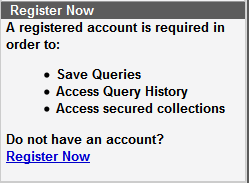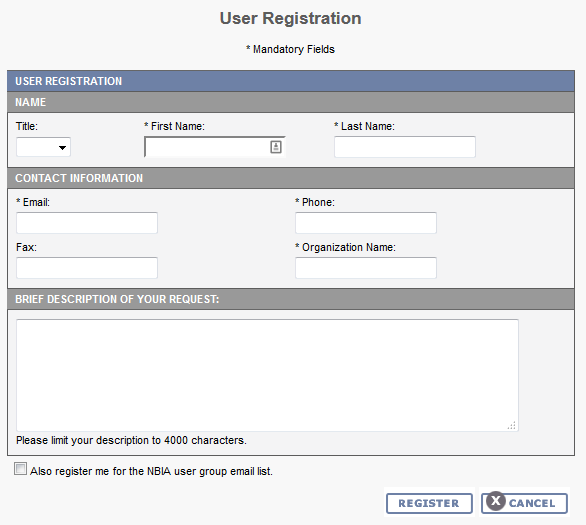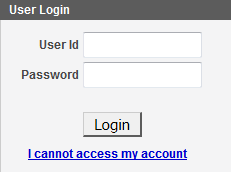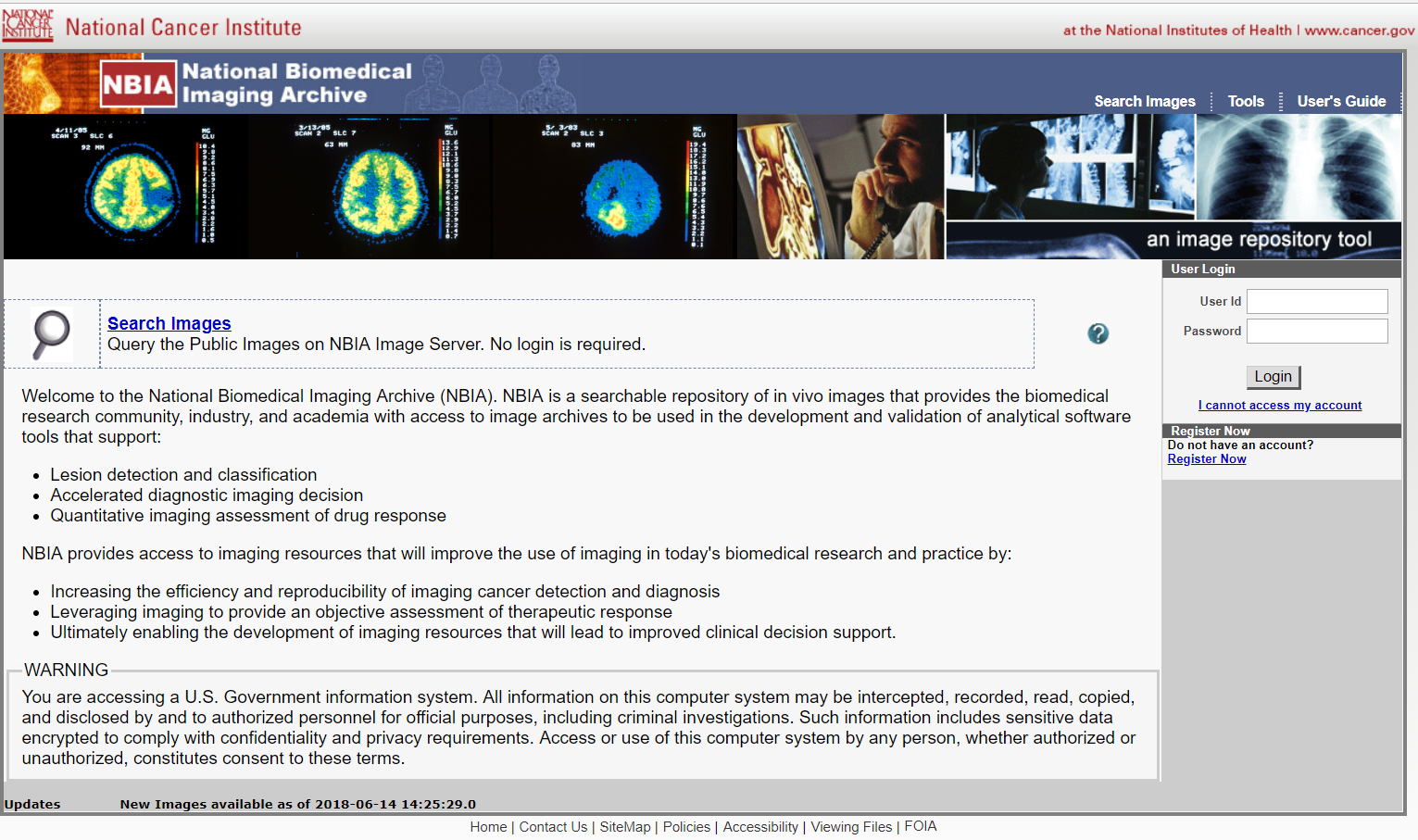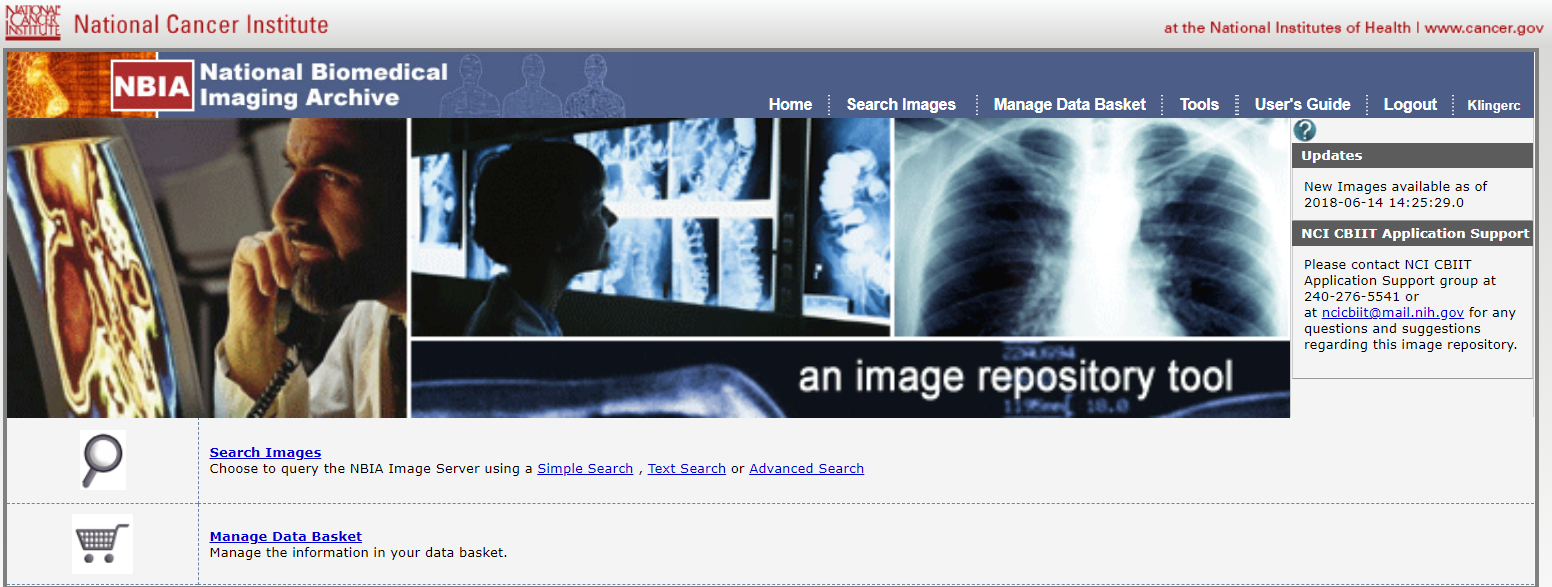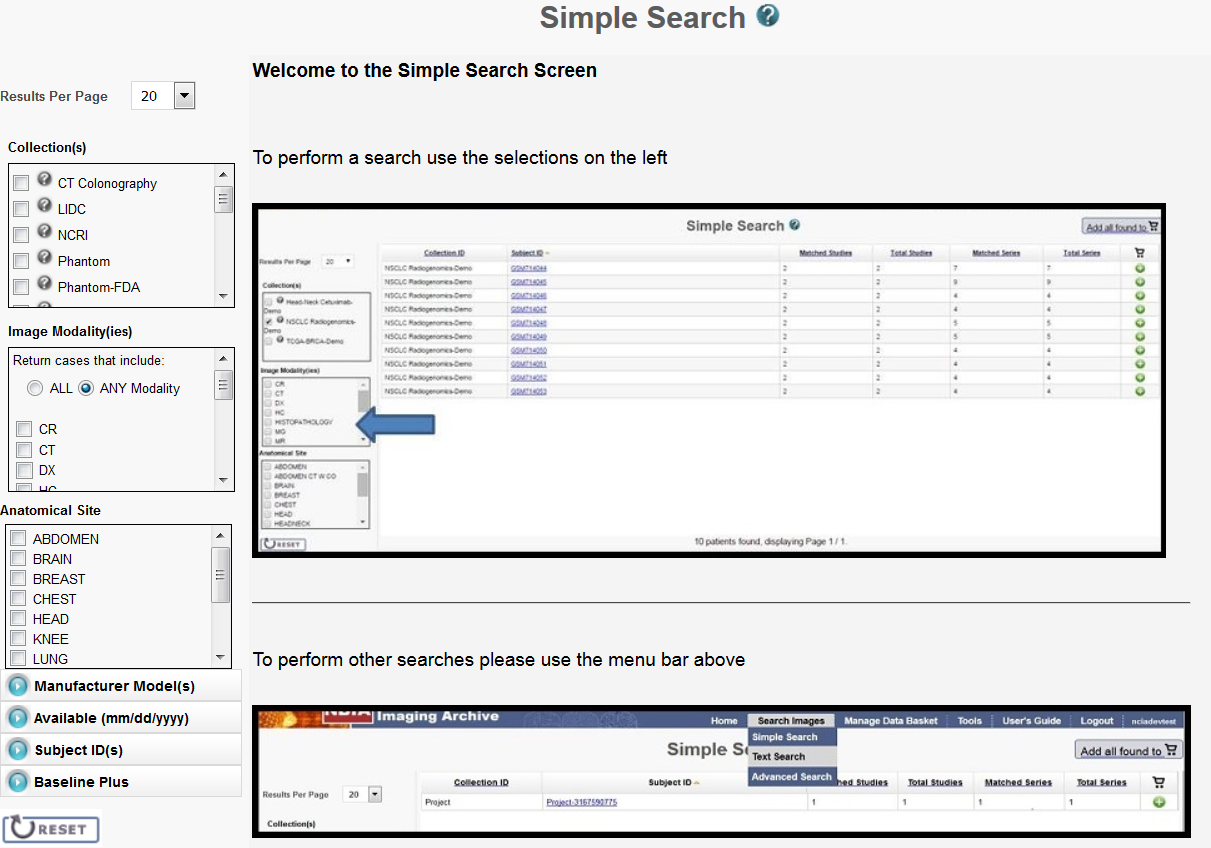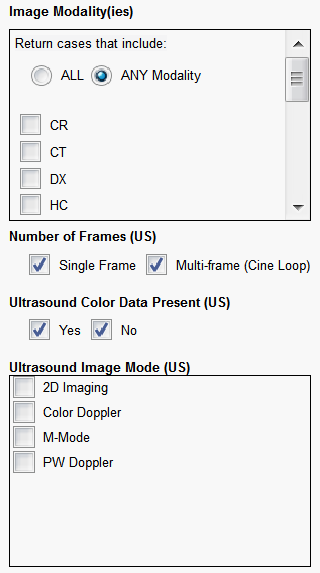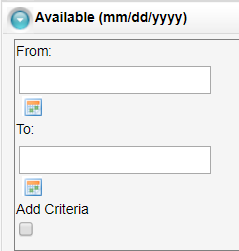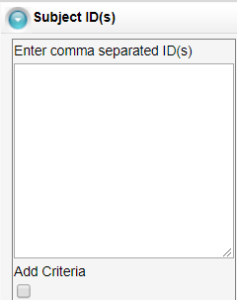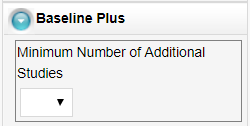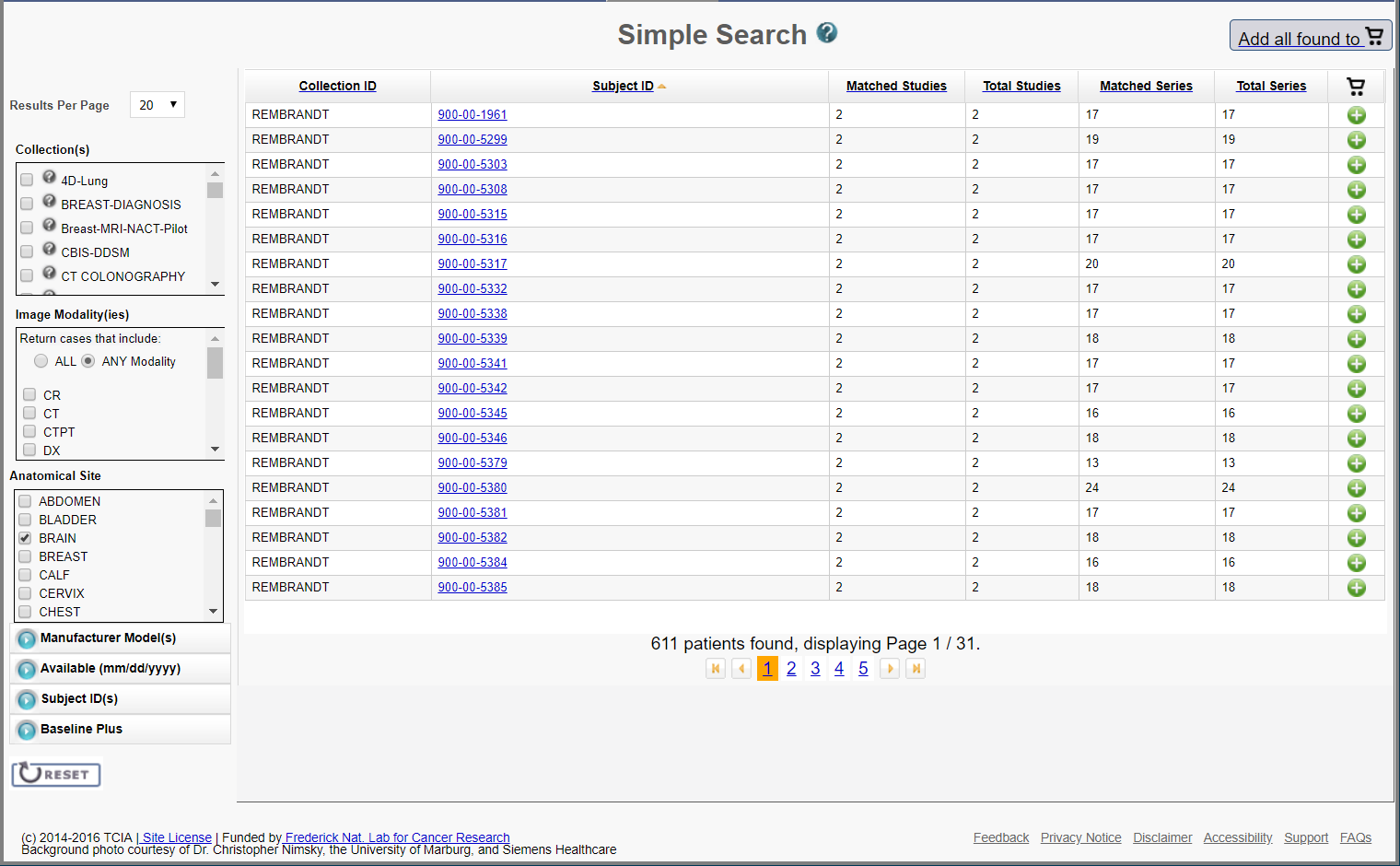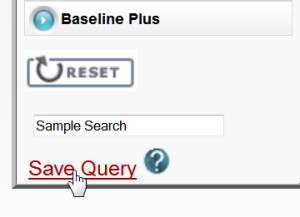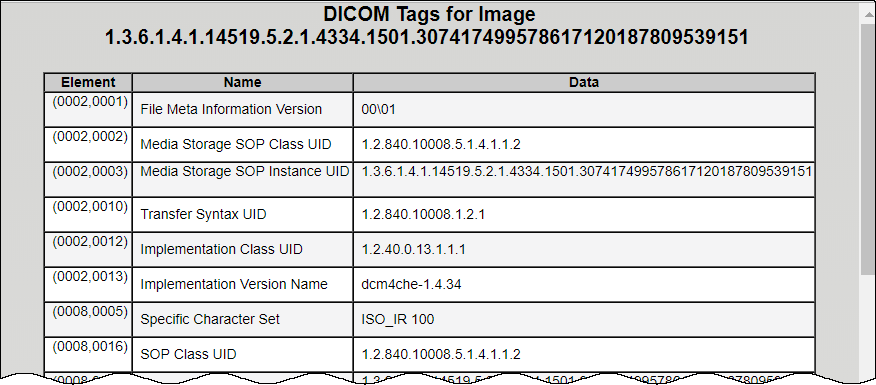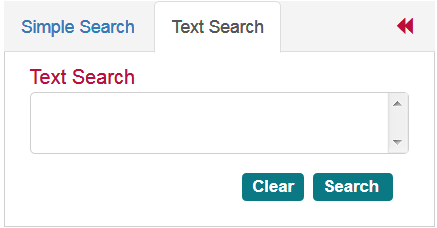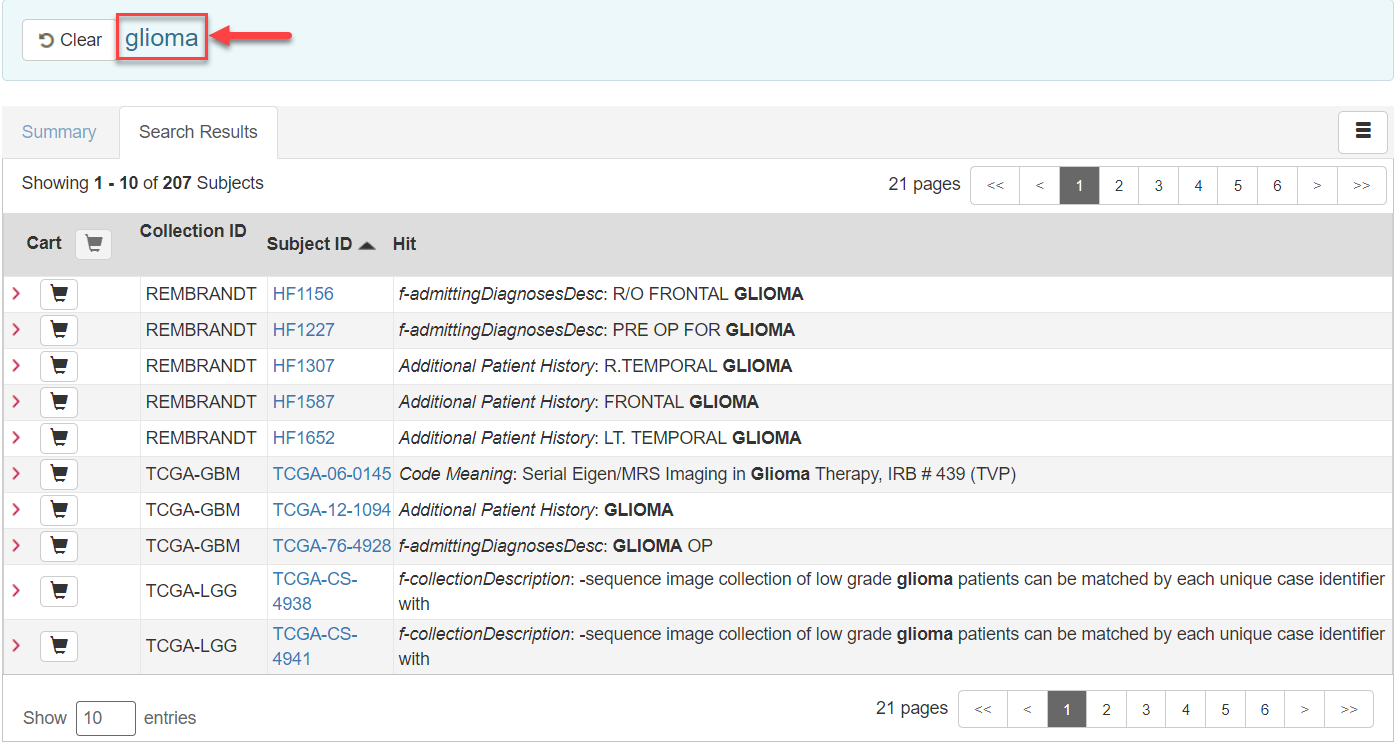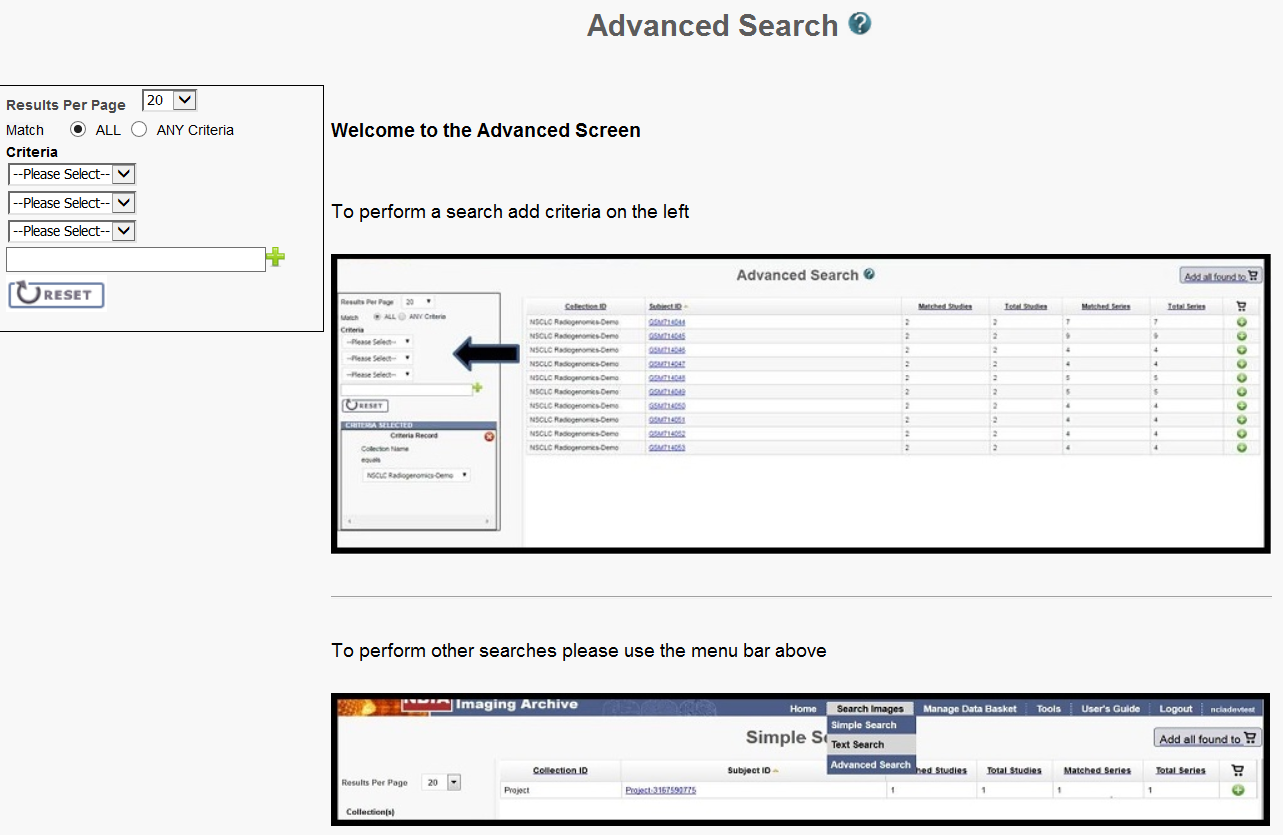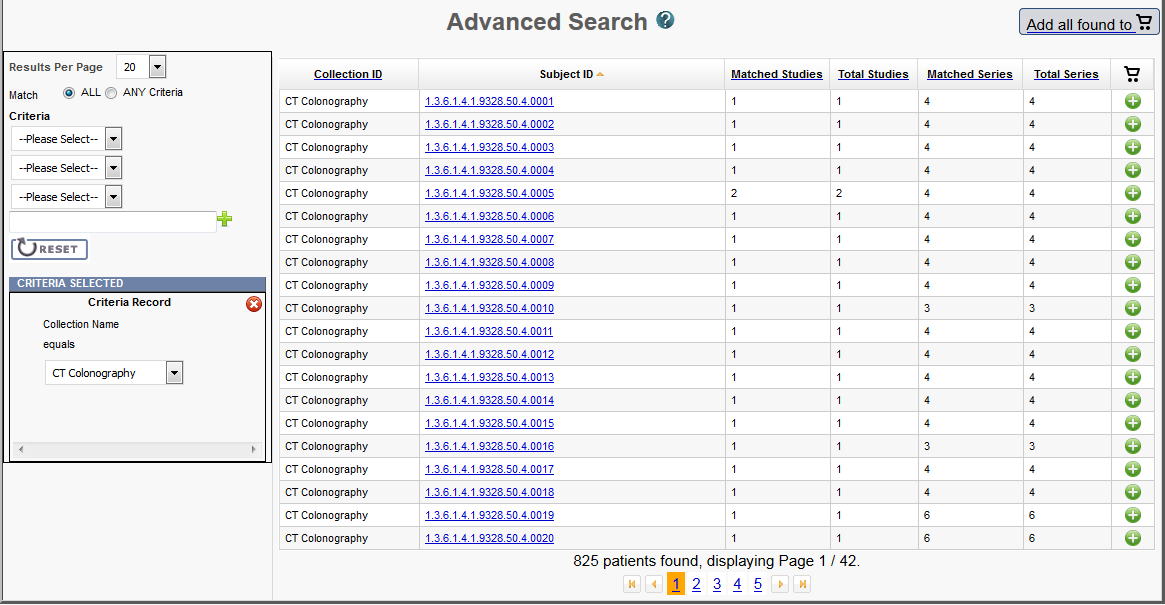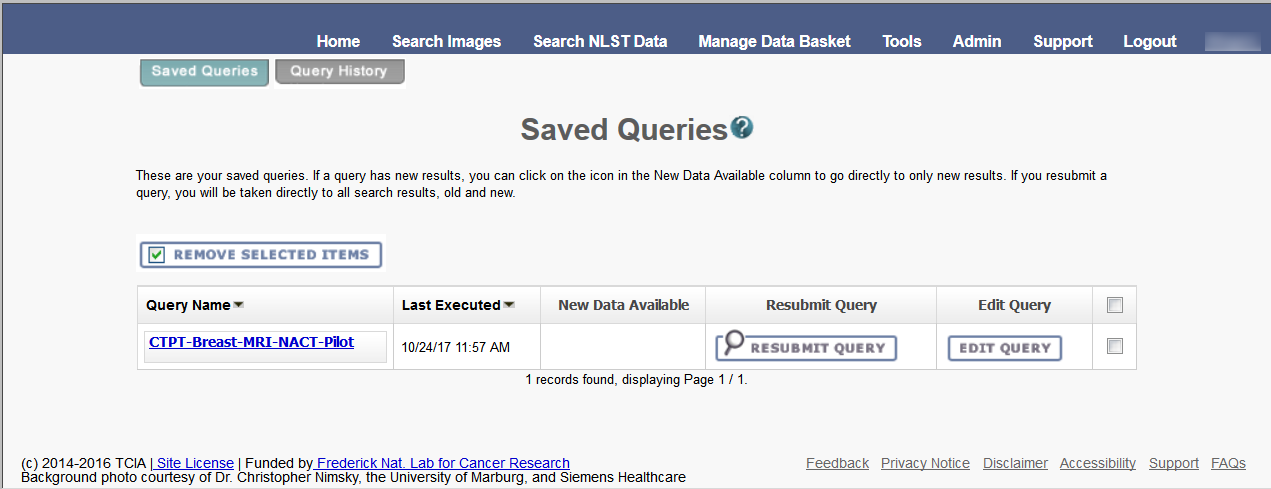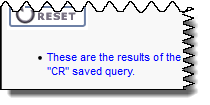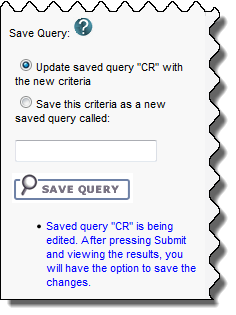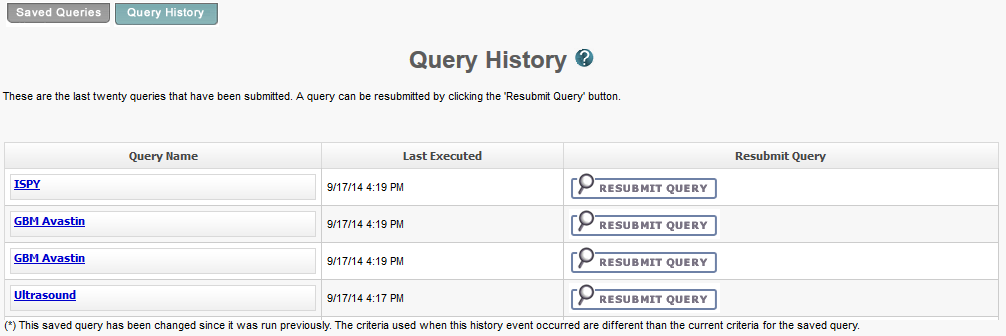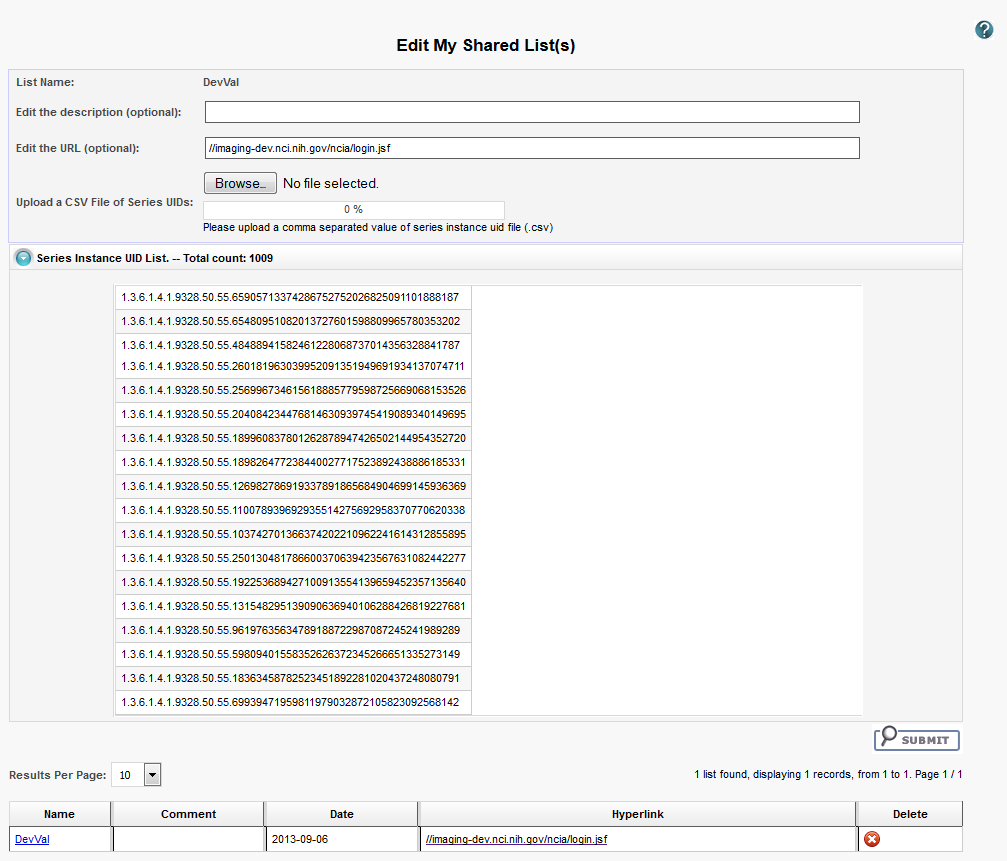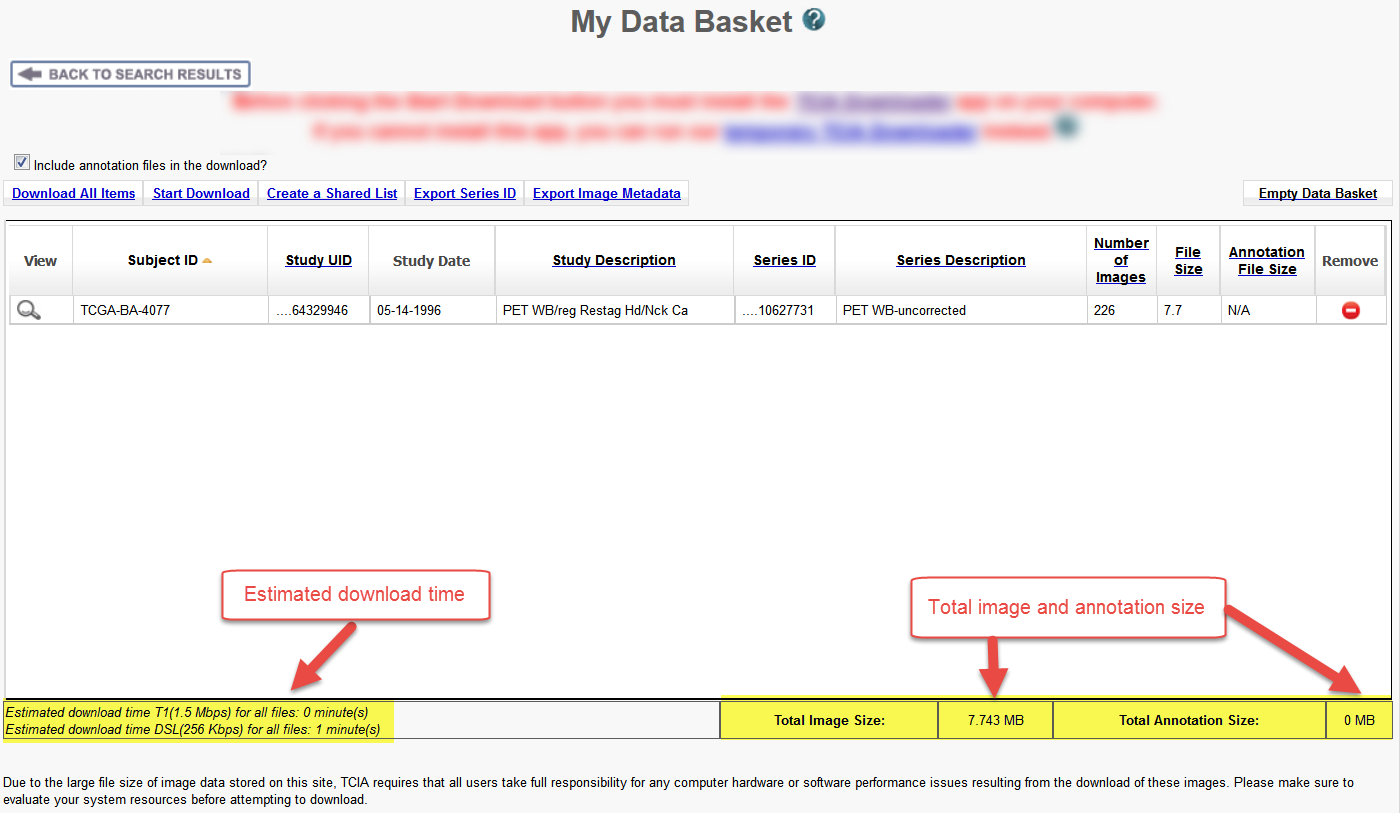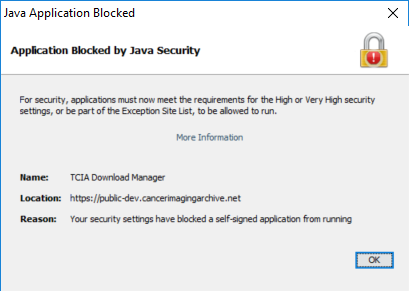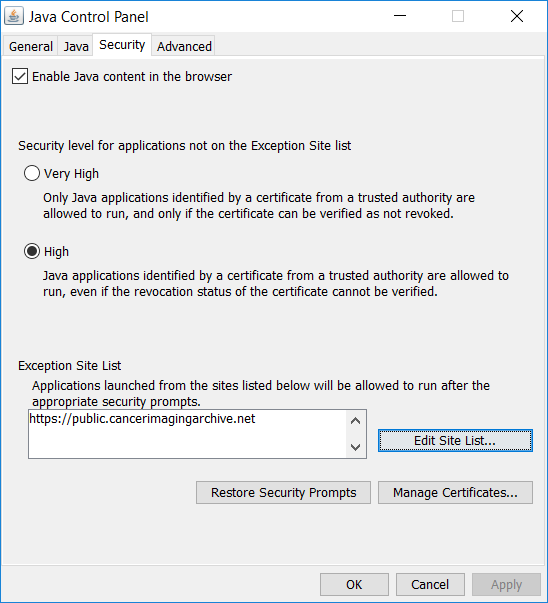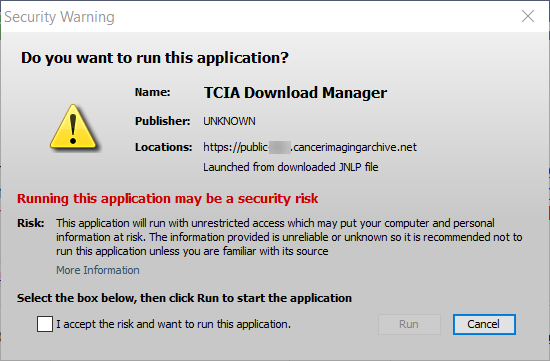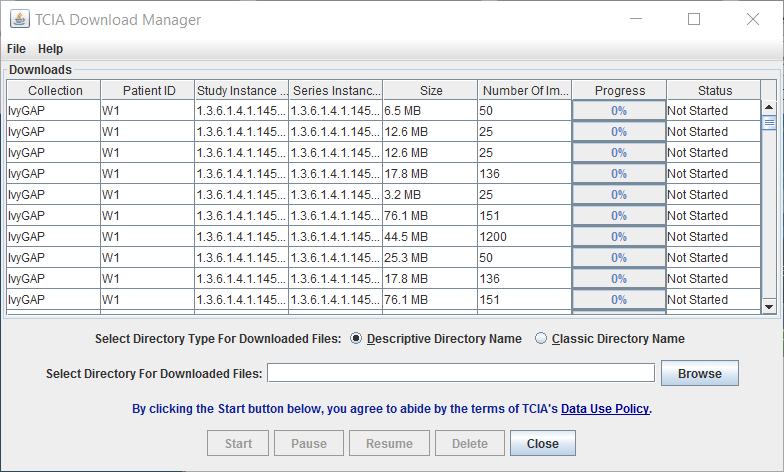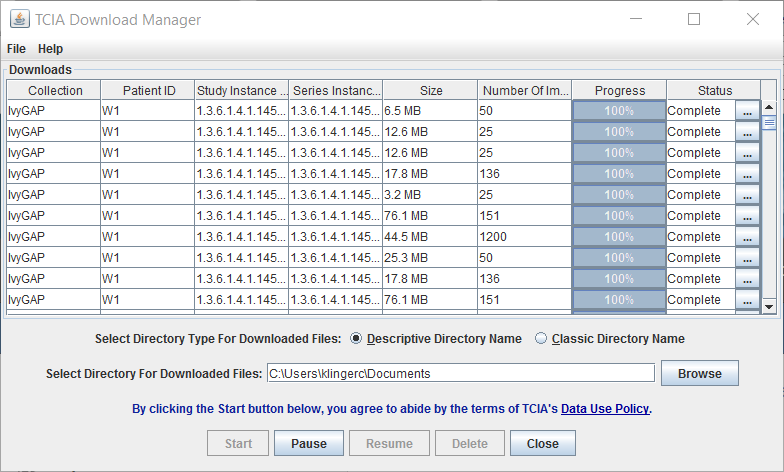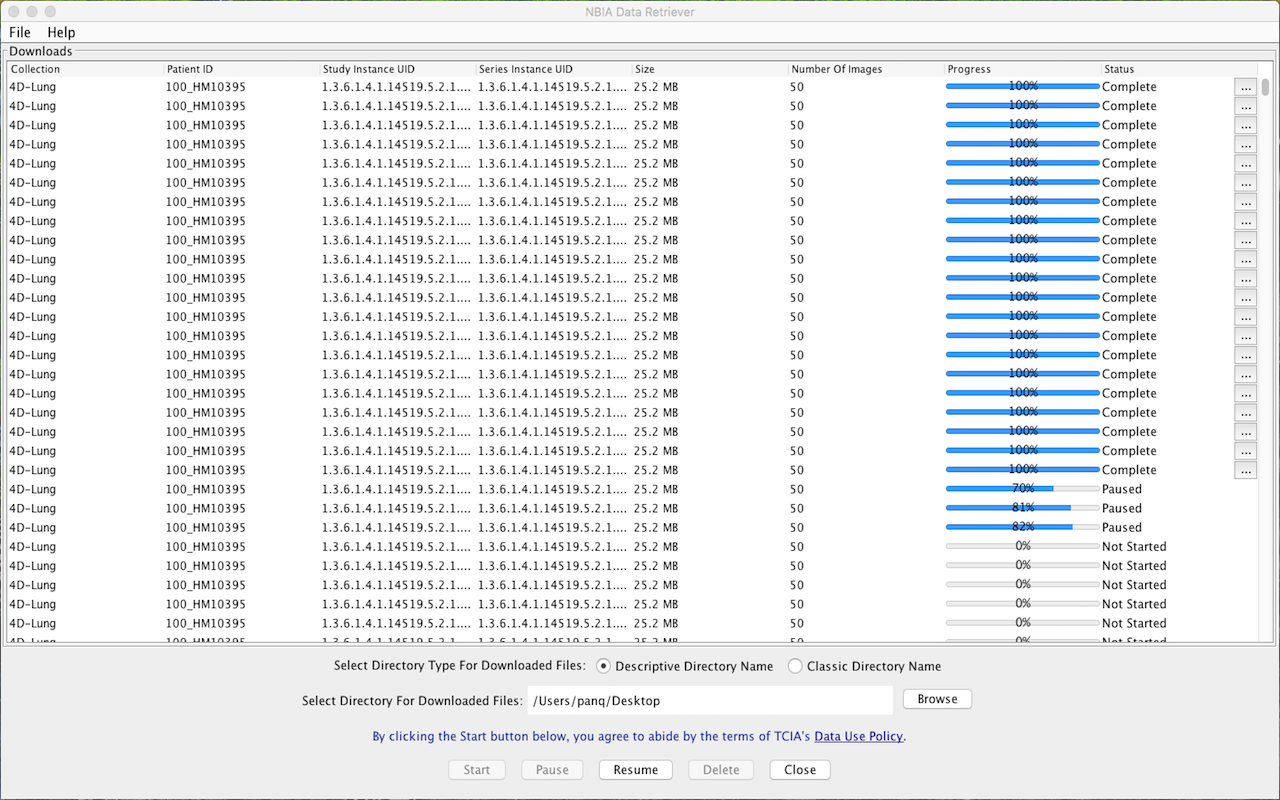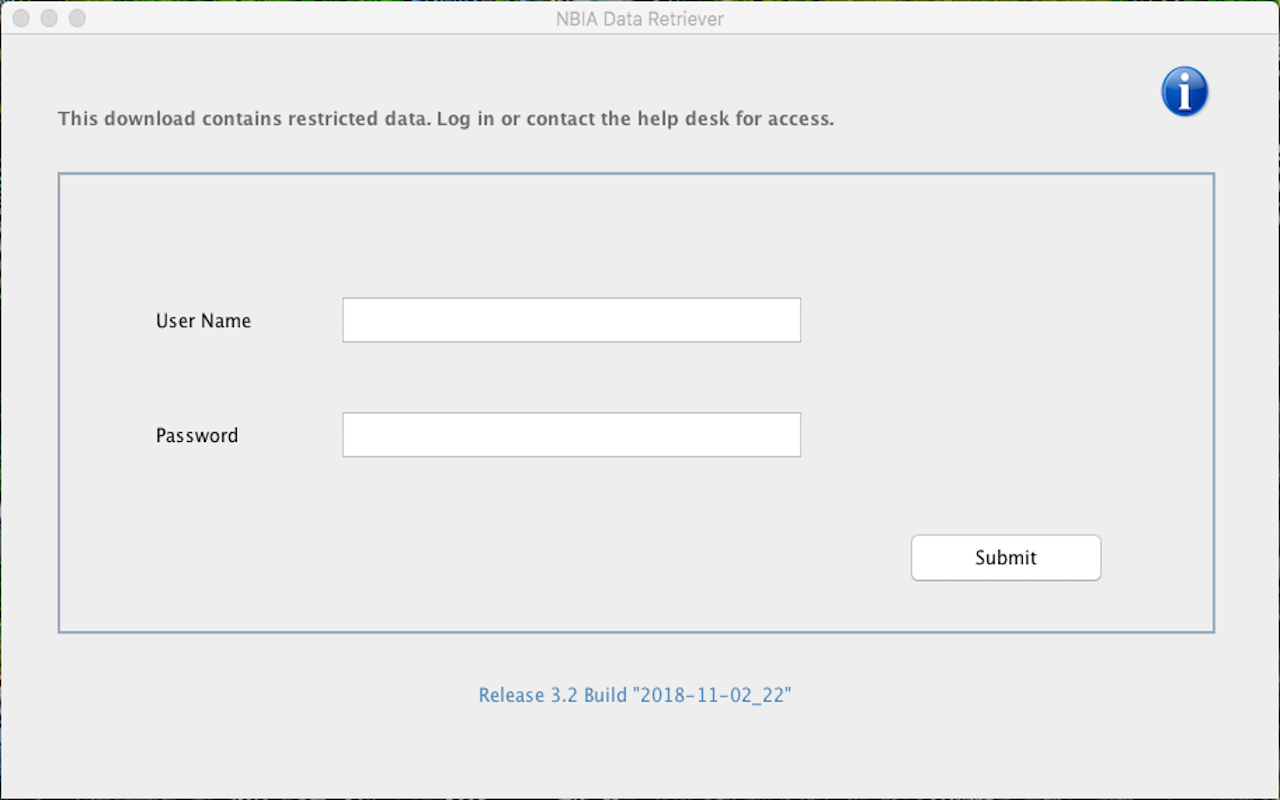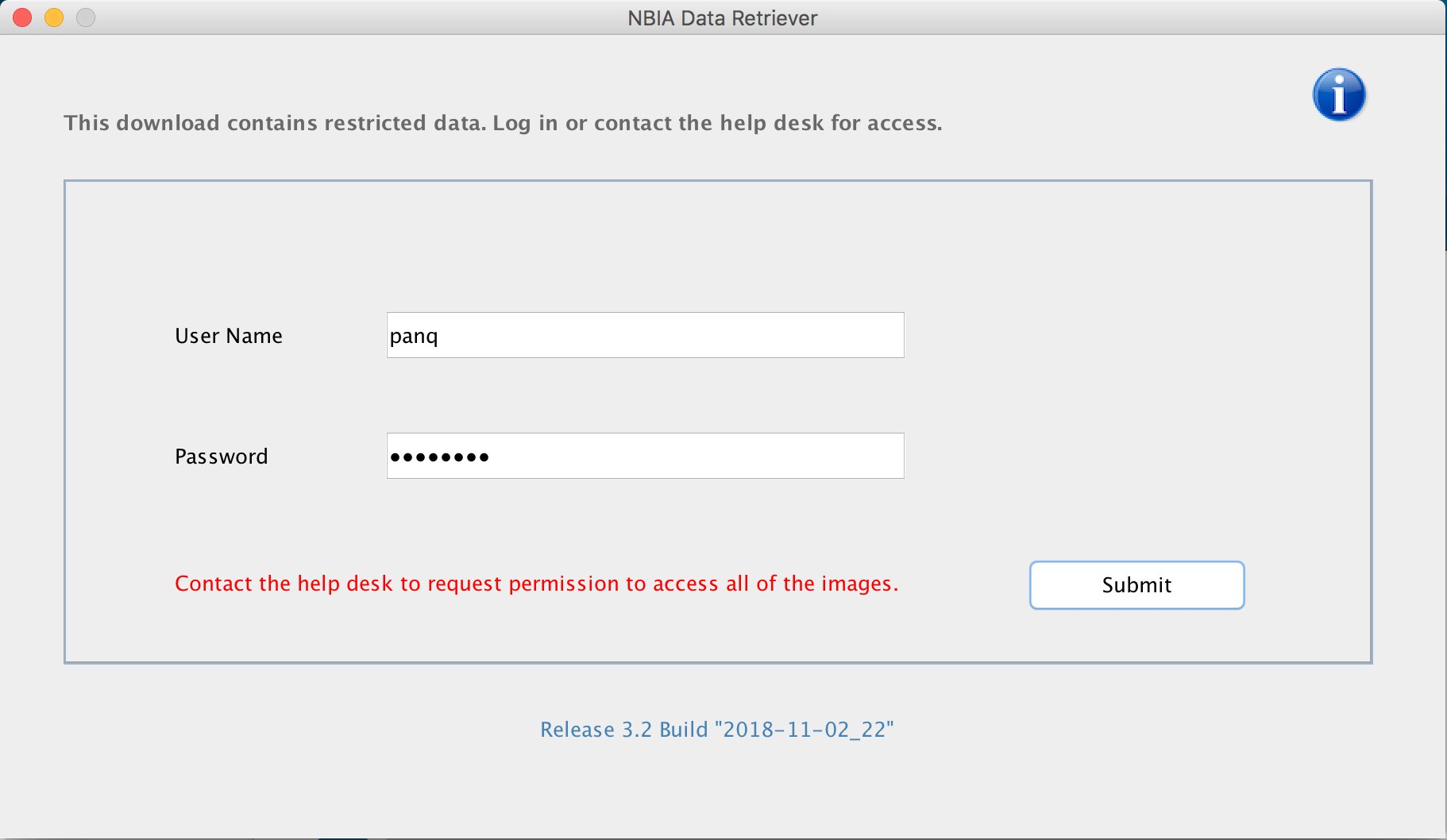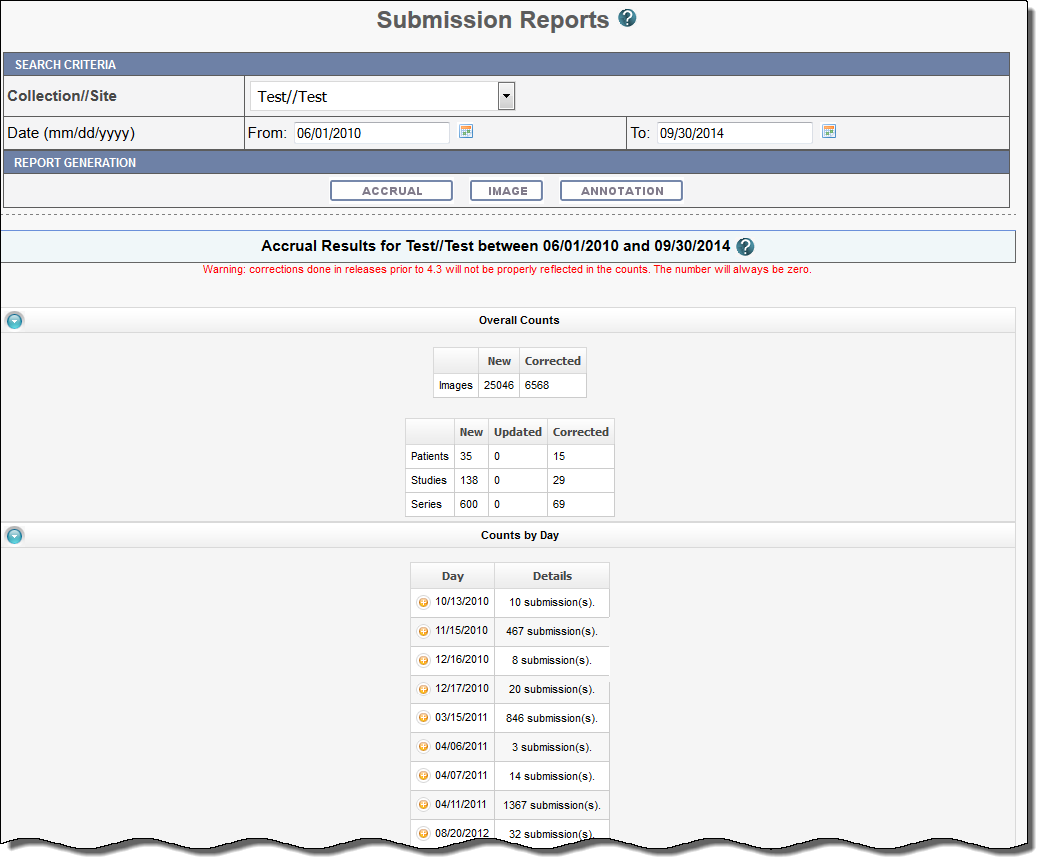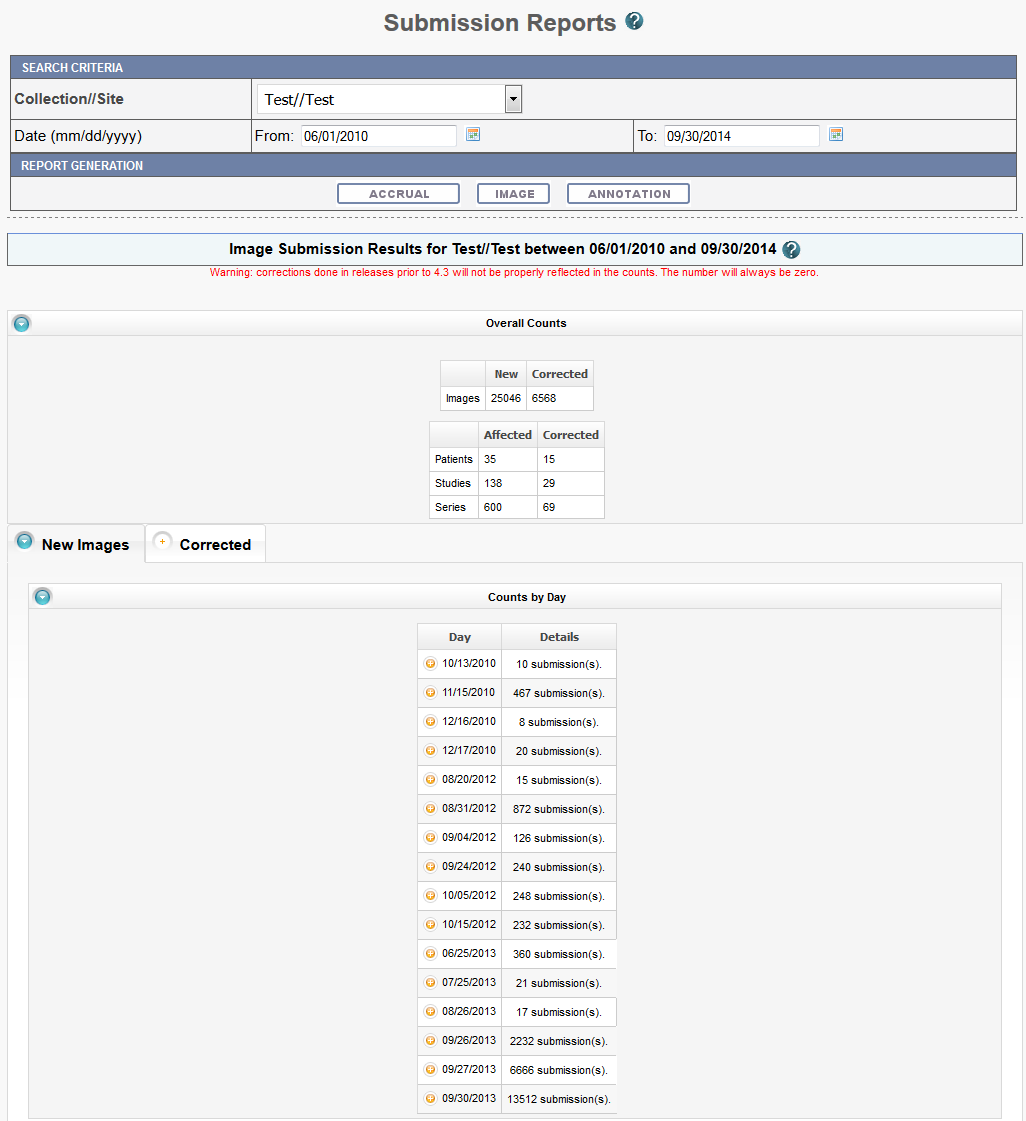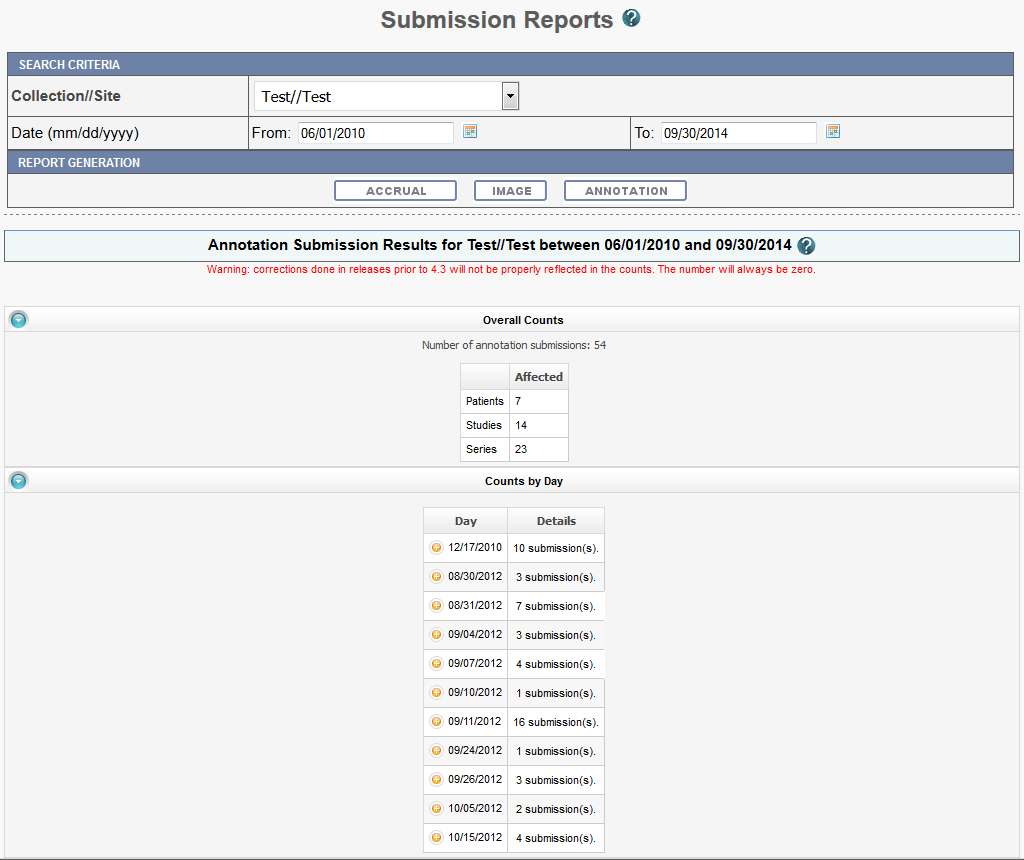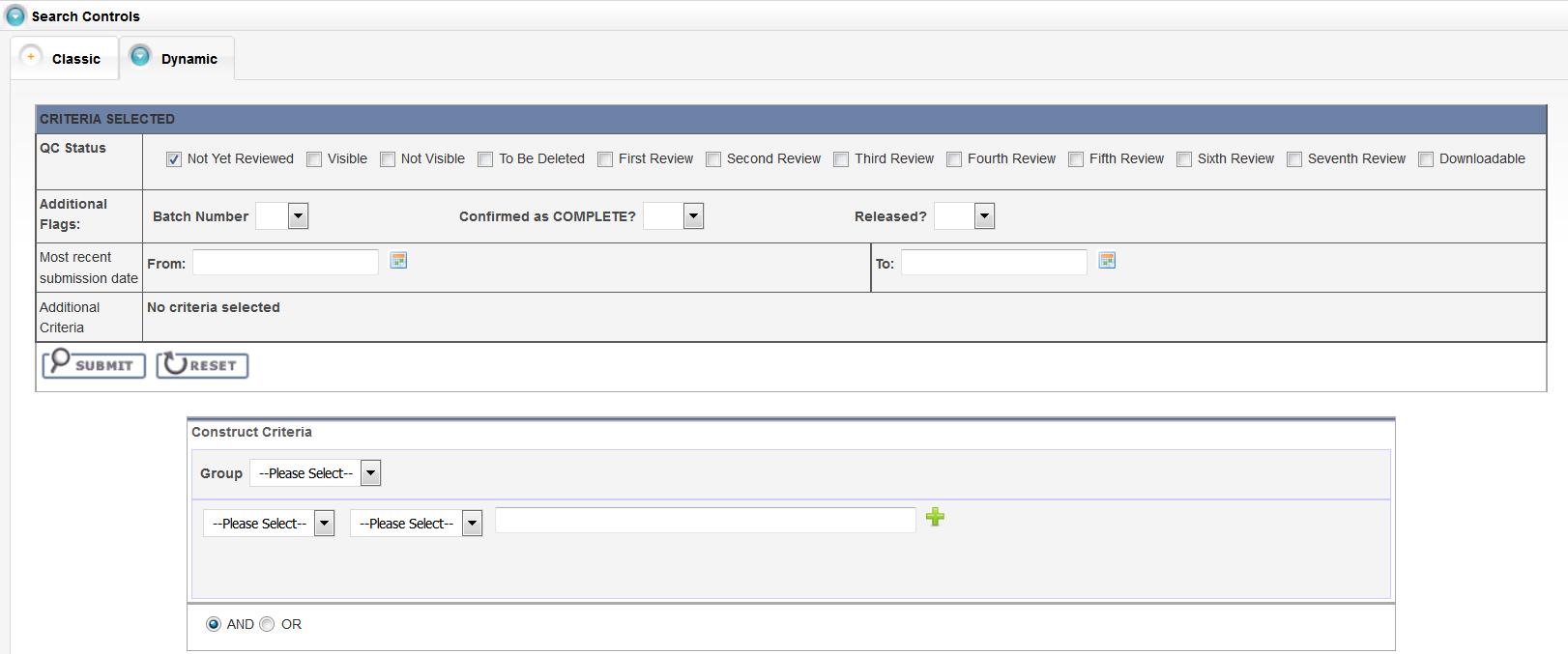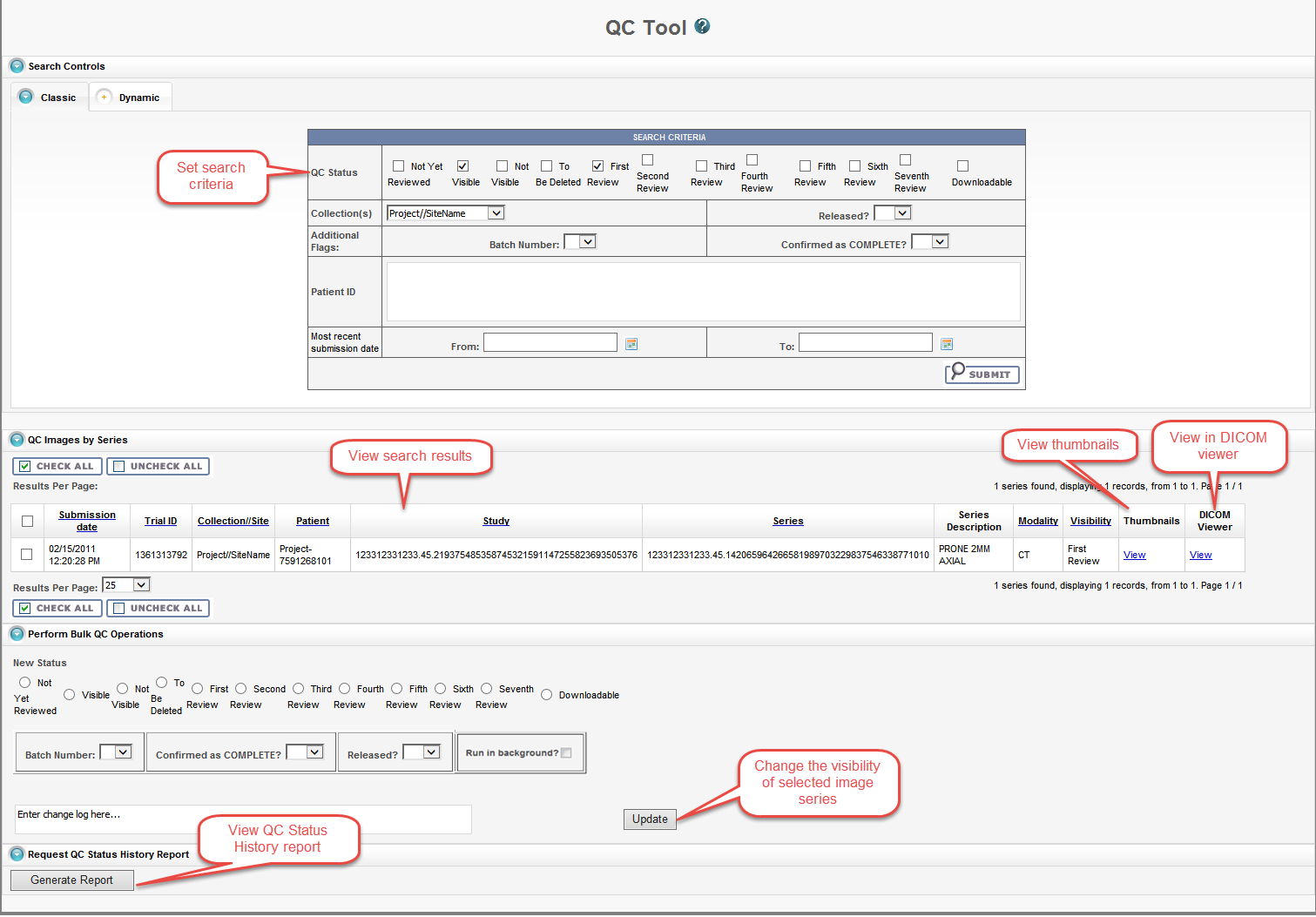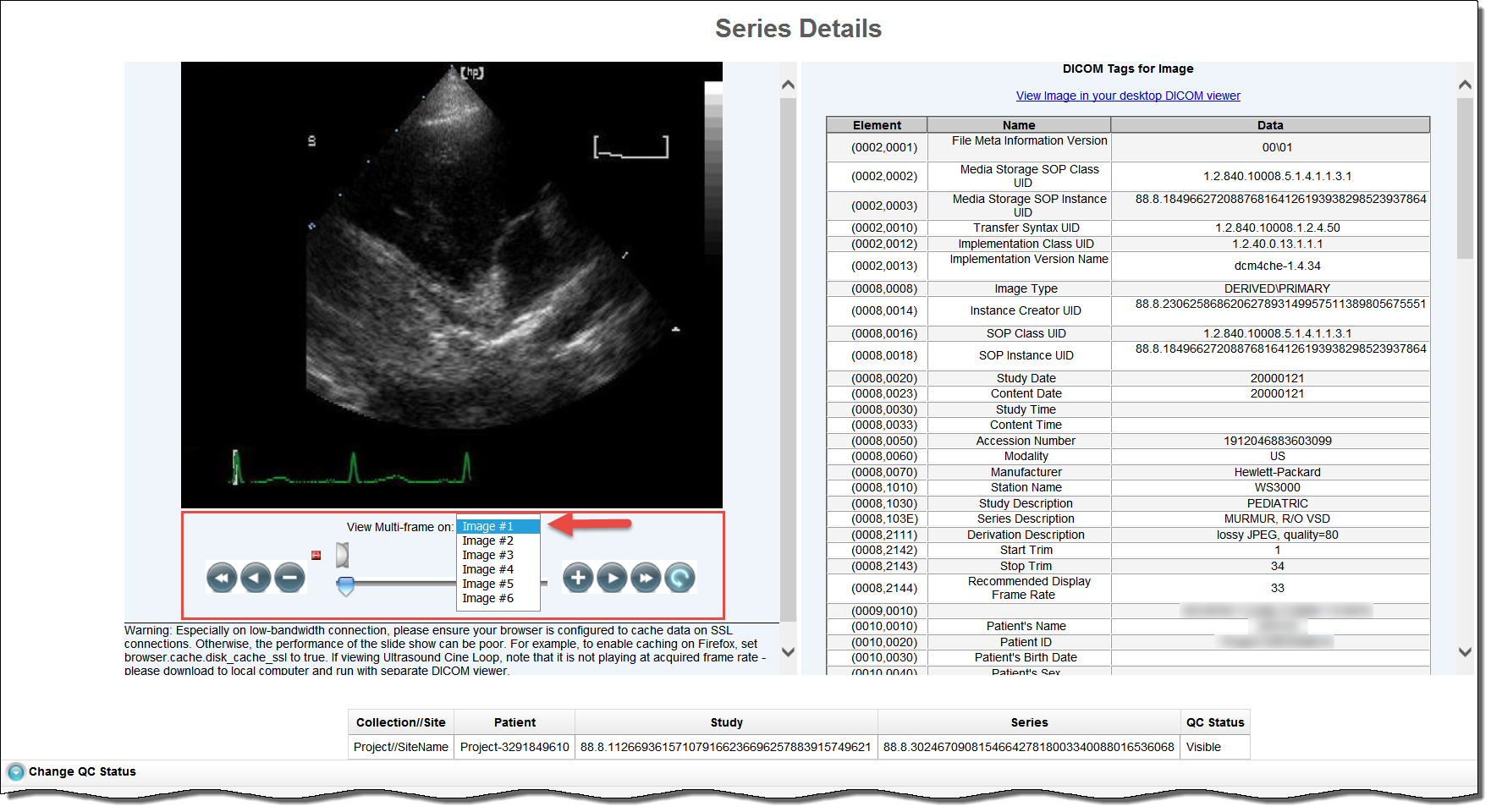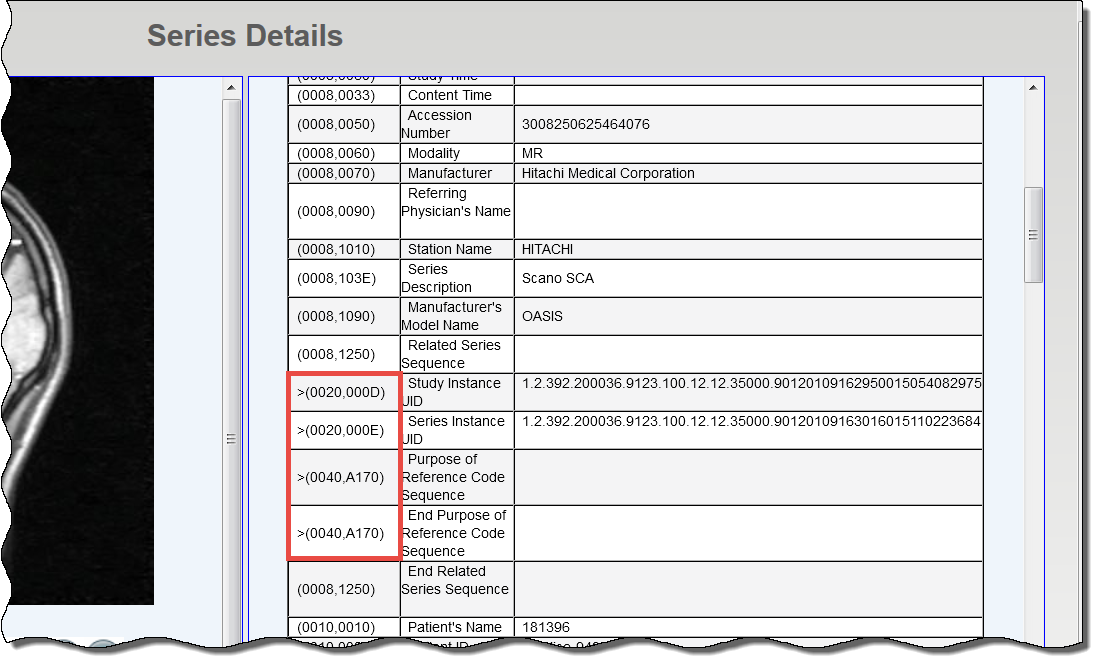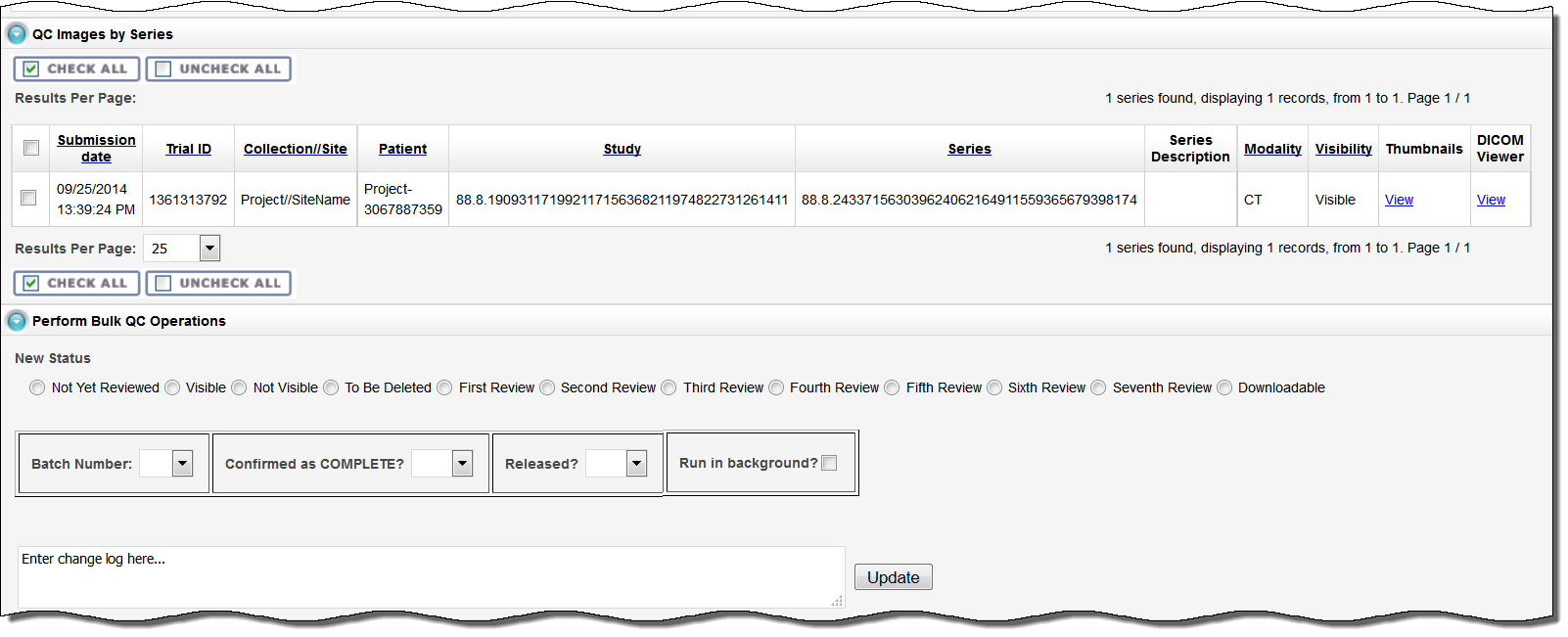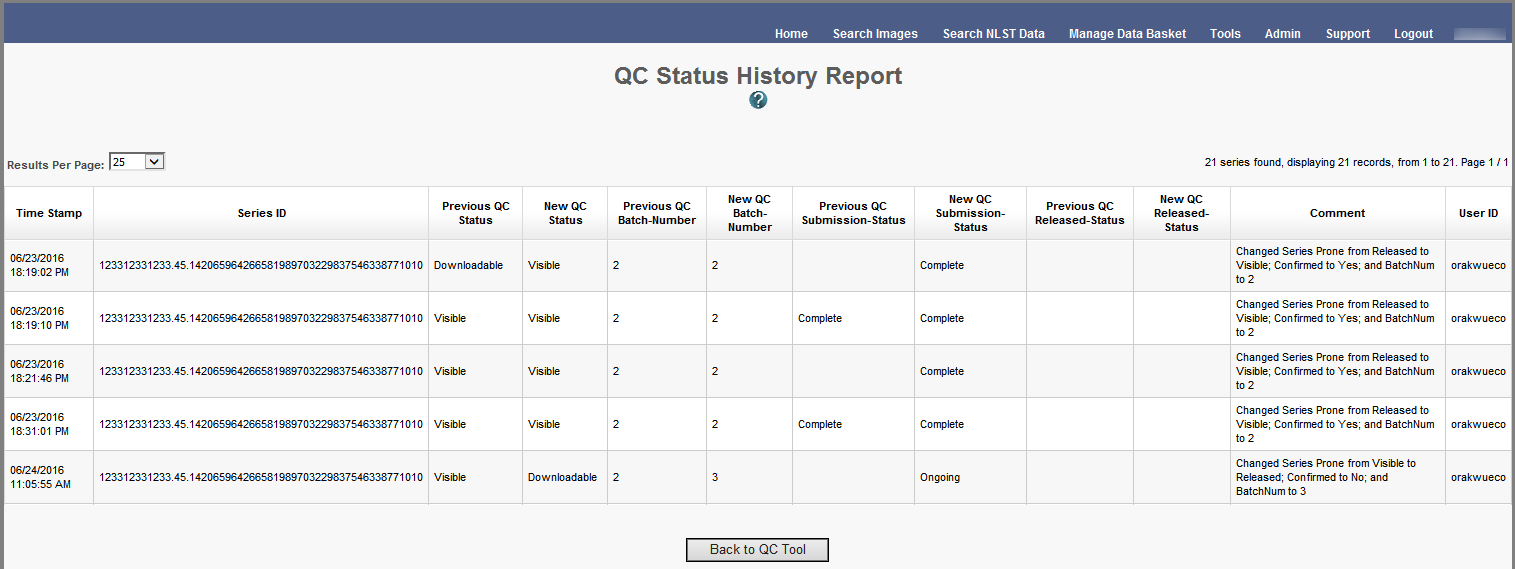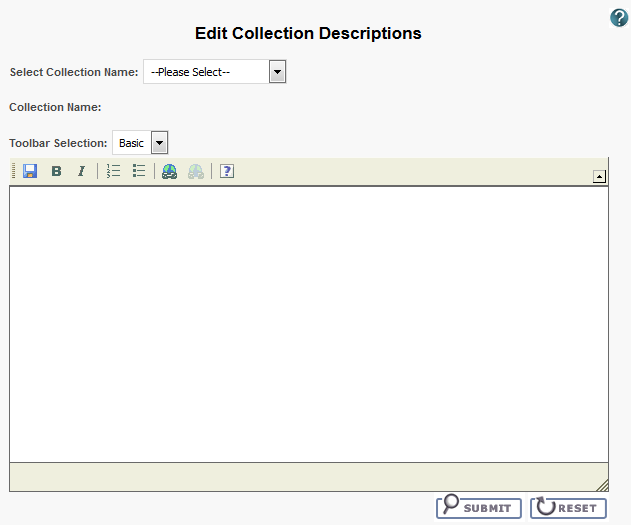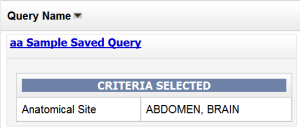This page contains the online help topics for the NBIA Classic interface, which is not the current release of NBIA. The user's guide for the new NBIA Data Portal interface is also available.
Registering a New User
- On the NBIA welcome page, click the Register Now link in the Register Now panel as shown below.
The legal provisions page appears. - Review the text on the page and click the link at the bottom to indicate your agreement and continue.
The registration form appears.
The legal provisions page appears. - Enter information for the new user. Required fields are preceded by an asterisk. Do not include special characters in your username, but your password can have special characters.
- Click Register to continue or Cancel to return to the homepage.
The NBIA administrator reviews your registration and creates the new account. Once you confirm the account registration, your account is registered. For more information, see Creating a New NBIA User.
Logging into NBIA
If you do not have a User ID or password, click Register Now to apply for a user account. For more information, see Registering a New User.
If you have already registered, perform the following steps to log in.
- In the User Login panel, enter your User ID and password.
Click Login. If your login is successful, the data portal appears.
Tip
NBIA uses popups. To prevent problems accessing the application, in your browser, enable a popup blocker exception for https://imaging.nci.nih.gov/ncia/login.jsf.
If you have persistent difficulty logging in, click I cannot access my account on the NBIA login page. An NBIA account help topic opens, describing help options for resolving your login problem. Alternately, contact Application Support.
Using the NBIA Home Page
After you log in, you have more options.
Options available from this page and links to more information about them follow.
Menu | Menu Option | Description | For more information, see |
|---|---|---|---|
Home | Return to the NBIA home page. |
| |
Search Images | Simple Search | Open the Simple Search page. | |
| Text Search | Open the Text Search page. | Performing a Text Search | |
| Advanced Search | Open the Advanced Search page. | Performing an Advanced Search | |
Manage Data Basket | Open the My Data Basket page. This is the same option as choosing Manage Data Basket from the menu bar. | ||
| Tools | List DICOM Image Viewers | Open a page displaying links to freeware DICOM image viewers. | |
| View Saved Queries | Open the Saved Queries page. | Working with Saved Queries | |
| View Query History | Open the Query History page. | Viewing Query History | |
| Create Shared List | Open the Create Shared List page. | Creating a Shared List | |
| Edit Shared List | Open the Edit Shared List page. | Editing a Shared List | |
| Search Shared List | Open the Search Shared List page. | Searching a Shared List | |
| Admin | Perform QC | Evaluate a submission and assign a QC status. Only administrative users have access to this menu. If you believe you should have access, contact Application Support. | |
| Approve Deletions | Approve the deletion of image series marked for deletion. | Approving Image Deletions | |
| Manage Shared List | Delete shared lists created by other users. | Managing a Shared List | |
| View Submission Reports | Run reports to verify that images have been received and to monitor the status of the submitted images. | Viewing Submission Reports | |
| Perform Online Deletions | Immediately remove images that are marked as approved for deletion. | Manually Deleting Image Series | |
| Edit Collection Descriptions | Add a brief description for a collection so that NBIA users know what data is in the collection. | Editing a Collection Description | |
| Manage Workflow Items | Create, edit, and delete workflow items that involve changing the visibility status of an image series and/or trigger a web service call to a URL. | Managing Workflow Items | |
| Manage Saved Queries | Review and delete saved queries. | Managing Saved Queries | |
Support | Open a browser window with support options. | ||
| Logout | Log out of NBIA and return to the NBIA home page. |
Using NBIA Online Help
Not logged in?
You can open the user's guide without being logged into NBIA.
Click Help > User Guides in the top menu bar to open the NBIA User's Guide on the NCI wiki.
On any application page, click to open the help topic that applies to features available on that NBIA page.
Performing a Simple Search
To perform a simple search
On the NBIA home page, click Simple Search or Search Images > Simple Search.
The Simple Search page appears.
Choose the search criteria as described in the following table.Description Simple Search Criteria Results per Page Select the number of search results per page the search will return.
Collection(s) Collections are NCI-defined groupings of image data sets. Select from the collections to which you can access. If none are selected, then the search returns data for all collections.Click the (?) icon next to the collection name to display a popup with the collection description if it exists.
Click Collection Descriptions for more information about the collections.
Image Modality(ies) Select from the available image classifications. If none are selected, then the search returns data for all modalities.
Specify whether to Return cases that include All or ANY Modality.
Modality description
Descriptive text for the modality displays when you hover the cursor over the option.
The NBIA data portal can perform ultrasound-specific searches. To launch an ultrasound image search, select US in the list of Image Modalities. When you do so, three additional search options display on the page, shown below. Configure the options appropriately for the ultrasound data you want to search.
- Number of frames: One ultrasound DICOM file can consist of multiple frames which you can specify in this option.
- Specify if Ultrasound Color Data is present.
- Specify one or more Ultrasound Image Modes.
If you choose to view an ultrasound DICOM file in animation, NBIA loops through all of the images in the file.
Anatomical Site To further restrict the search, optionally choose the anatomical site of interest. Manufacturer Model To restrict manufacturer model results, uncheck All Manufacturers. Expand and display the list as needed, and select the items to restrict the search. Available (mm/dd/yyyy) To restrict results to the date the image became available in the system, expand the panel, enter from and to dates and select Add Criteria to perform the search.
Subject ID To restrict results to a comma-separated list of patient IDs, expand the panel, enter the list of patient IDs, and select Add Criteria to perform the search.
Baseline Plus Expand the panel and specify the Minimum Number of Additional Studies.
To clear the search criteria and start over, click .
The search results appear.
Save the Query
You can save your search criteria to make it easier to repeat this query in the future. After you have selected one or more search criteria, the Save Query link appears at the bottom left of the page.
To save a search query- Select search criteria.
In the box above the Save Query link, enter a name for your query.
Click Save Query.
The query is saved. You can see it by selecting Tools > View Saved Queries.
For more information, see Managing Saved Queries.
Navigation Tips
- Click the down arrow next to a column title to sort the column by that item.
- Click the arrows at the bottom of the table to display the first, previous, next, or last page of results.
- Click the page number links to move to a specific page of results.
The Search Results (Studies for Subject) page shows studies associated with the subject that you selected on the Search Results by Subject page. Each study, identified by Study Instance ID, Description, and Date, is followed by a table with rows for each image series in the study. At the top and bottom of the page, breadcrumbs in the format Search >> Study show the level of the data on the page. Clicking Search in those breadcrumbs returns you to your original search results.The following table describes the data available for each study and image series in that study.
Field
Description
DICOM Web Viewer link Click this link to see all study images in the DICOM Web Viewer.
Series
Series identification number
Description
Description of the series
Modality
Image modality
Manufacturer
Name of the manufacturer of the image series
Images
Displays the number of images in the series. This number includes visible images that meet the search criteria.
Thumbnails Click this link to display thumbnails of the series' images. For more information, see Search Results (Images for Series).
Cine Mode Click in a series record to launch an animation of the series. This feature is only available when two or more thumbnails are available for the series. For more information, see Viewing Image Animation.
DICOM Click to open a new window that displays DICOM metadata about the first image in the series.
Each image series can have multiple images whose thumbnails display in this search results page. While each image has its own DICOM file whose attributes may vary slightly from the others in the series, the DICOM file that opens displays values for only the first image in the series. These values represent the values for all images in the series.Add to Basket
- Click to select a series and add it to your data basket, or to remove it from your data basket.
- To mark all series in the search results as records you want to add to your data basket, click .
For more information, see Managing the Data Basket.
Add a Study series to Basket To add only the series in a single study in the search results to your basket, click in the Add This Study to Basket section.
Performing a Text Search
Text search does have some restrictions. These are:
- The text string you use must have more than one character. The search won't return any values if the text string has only one character.
- Do not use a forward slash (/) in your text string.
- Do not use complex searches with AND or OR statements (text search supports Lucene syntax but only a single field can be searched at a time).
To perform a text search
On the NBIA home page, click Text Search or Search Images > Text Search.
The Text Search page appears.- Select the number of search results per page you want the search to return.
- In the box at the top of the page, enter a text string of two characters or more.
Click .
The search results appear.
Navigation Tips
- Click the down arrow next to the Subject ID column header to sort the results alphabetically (A to Z or Z to A) by Subject ID.
- Click the arrows at the bottom of the table to display the first, previous, next, or last page of results.
- Click the page number links to move to a specific page of results.
- In the Show (10) entries box in the bottom left, edit the default 10 to the number of entries you want to see on a search results page.
- For performance Text Search will only return the first 3000 subjects that match the criteria
The following table describes each item in the search results table.
| Search Result | Description |
|---|---|
| Click the caret to view the subject details. Click the cart symbol to add image series to your cart. | |
| Collection ID | Collection identifier |
| Subject ID | Click the Subject ID to view the details for all study images for this subject, a single series' thumbnails, or the DICOM header for the first image in the series. |
| Hit | The field in the study where the text string that you entered in the search criteria appears. |
Performing an Advanced Search
To perform an advanced search
- On the NBIA home page, click Advanced Search or Search Images > Advanced Search.
The Advanced Search page appears.
- Select the number of search results per page the search will return.
- From the Match options, select ALL to find image series that meet all of your search criteria or select ANY Criteria to find image series that meet any of your search criteria.
- From the first Criteria list, select an NBIA entity. Your selection here determines the options available for the rest of the search criteria.
Select options from the lists or enter text into the box as needed to perform your search. If you enter text into the box, click the Add icon () for each set of criteria you define.
As soon as you specify the final criterion, the criteria you selected appear in the box below the criteria and the search results appear to the right.Modality searches
Modality searches only support the CT and MR modalities.
Navigation Tips
- Click the down arrow next to a column title to sort the column by that item.
- Click the arrows at the bottom of the table to display the first, previous, next, or last page of results.
- Click the page number links to move to a specific page of results.
The following table describes each item in the search results table.
Search Result Description Collection ID Collection identifier Subject ID Click the Subject ID to view all study images for this subject in a DICOM web viewer, a single series' thumbnails, or the DICOM header for the first image in the series. See Search Results (Studies for Subject).
Matched Studies Total number of studies for this subject that match the search criteria
Total Studies Total number of studies for the subject Matched Series Total number of image series for the subject that match the search criteria Total Series Total number of image series for the subject Add the images for a single series or the entire study to your data basket. When you have marked a record for addition to the data basket, it is highlighted in yellow.
- Click to select the record and to clear it.
- To mark all records in the search results as records you want to add to your data basket, click the basket icon in the column header or click .
For more information, see Managing the Data Basket.
To further refine your results, select new search criteria. These new criteria filter your existing results and as with the previous search, the criteria you selected appear in a box below the criteria. Click the to delete the record from the page or click to delete all criteria and start over.
Creating Saved Queries
- Select search criteria.
In the box above the Save Query link, enter a name for your query.
Click Save Query.
The query is saved. You can see it by selecting Tools > View Saved Queries.
Working with Saved Queries
The following procedures are associated with saved search queries.
Editing Saved Queries
Disallowed Collections and Saved Queries
If you save a query when you have access to a collection then subsequently lose that access, you do not lose the saved query. However, records from a disallowed collection are not included in the search results.
To view, edit, and resubmit saved queries
- Select Tools > View Saved Queries.
The Saved Queries page appears.The query table is sorted in descending order by Last Executed date by default. You can also sort by Query Name by clicking on the down arrow next to the column title.
The following table describes the information about your saved queries on this page.
Saved Query | Description |
|---|---|
Query Name | The name of the query displays as a link. The default is that the criteria themselves do not display. The link toggles whether the criteria for the saved query displays. Click the link to display/not display the criteria selected for the query. |
Last Executed | The most recent date and time you executed the query displays. The time is displayed for the Eastern Time (US and Canada) time zone. |
New Data Available | An icon () appears if new data is available for the saved query. Click the icon to display the results (new data only) on the Search Results page. |
Resubmit Query | Click this button to open the Simple Search page showing all available results of the currently saved search criteria. A message appears in the lower left corner identifying the source of the search results. |
Edit Query | Click this button to open the Simple Search page with the currently saved search criteria selected. In the lower left corner of the page, the Save Query section provides the options to update the saved query with new criteria or to save these criteria as a new saved query, with a box for the new query name. Select an option and click Save Query. |
Check Box | Click the check box to mark the query for deletion. You can click the checkbox in the header to select all queries or you can select queries individually. Click Remove Selected Items. The Manage Saved Queries page displays a message indicating success or failure and any additional actions that are required. |
You can also perform the following action on the Saved Queries page.
| Action | Description |
|---|---|
| View Query History | Click the Query History tab. The View Query History page appears. For more information, see Viewing Query History. |
Viewing Query History
- Select Tools > View Query History link
or
Click the Query History tab from the Saved Queries page.
The Query History page appears. The Query History page displays a table of the last twenty queries that you executed. These include saved queries that you resubmitted as well as queries you have not saved.
The Query History page contains the following information:
Field Name | Description |
|---|---|
Query Name | The name of the query displays as a link. The link toggles whether the criteria for the executed query is displayed. The text of the link can appear in three different ways depending on the situation.
|
Last Executed | The date and time that you executed the query. The time is displayed for the Eastern Time (US & Canada) time zone. |
Resubmit Query | Click the Resubmit Query button to submit the query using the saved criteria. The results display on the Search Results page. |
Click the Saved Queries tab to view, edit, or resubmit saved queries (see Managing Saved Queries).
Search Results Studies for Subject
The following table describes the data available for each study and image series in that study.
Field | Description |
|---|---|
| DICOM Web Viewer link | Click this link to see all study images in the DICOM Web Viewer. |
Series | Series identification number |
Description | Description of the series |
Modality | Image modality |
Manufacturer | Name of the manufacturer of the image series |
Images | Displays the number of images in the series. This number includes visible images that meet the search criteria. |
| Thumbnails | Click this link to display thumbnails of the series' images. For more information, see Search Results (Images for Series). |
| Cine Mode | Click in a series record to launch an animation of the series. This feature is only available when two or more thumbnails are available for the series. For more information, see Viewing Image Animation. |
| DICOM | Click to open a new window that displays DICOM metadata about the first image in the series.
|
Add to Basket |
For more information, see Managing the Data Basket. |
| Add a Study series to Basket | To add only the series in a single study in the search results to your basket, click in the Add This Study to Basket section. |
Creating a Shared List
Who can create a shared list?
Anyone can create a shared list. Once you do so, you must record the exact name of the shared list to distribute to others who may want to use the list. That is the only way they can access it.
To create a shared list
You can create a shared list from data basket or the Tools menu. Procedures for both methods follow.
Data Basket
- Add an image series that you want to include in the shared list to the data basket.
- Click the Create Shared List button.
- Do the following:
- Enter a Name for the list (required).
- Optionally, add a description and a URL. The URL links to relevant or more detailed information about the list.
- Click Browse to upload a file in comma separated value format (.csv) that includes all of the series instance IDs you want to be in the shared list. This file should have one series instance UID per line.
- Click Submit.
The image series from the uploaded file is added to the data basket.
Access to your list
NBIA warns you that not all public users will have access to your list if the list contains any non-public image series.
Menu Option:
- Click Tools > Create Shared List.
The Create Shared List page appears.
- On this page, do the following:
- Enter a Name for the list (required).
- Add Comments and a Hyperlink, where appropriate, which links to relevant or more detailed information about the list (optional).
- In the Upload File field, enter the name of a file that includes all of the series instance IDs you want to be in the shared list. This file should have a series instance UID per line.
- For your convenience, a Java tool is available to aid in generating a CSV of your series instance UIDs.
Download: ExtractSeriesUIDs.zip
Do the following to use this tool to generate the file to upload in the last field of our online Create Shared List form:- Download the zip file, then move it to a top-level directory of DICOM files you want indexed.
- Extract the zip file to the top level directory where your DICOM data resides (all sub-directories will be scanned). It should extract two things.
- Then run ExtractSeriesUIDs.bat which should flash a quick command line window and then automatically disappear.
A file with a name similar to SeriesUIDs.CSV is created as an output. - Enter the output filename into the form.
- Click Submit.
The image series from the uploaded file is added to the data basket.
Searching a Shared List
To search for a shared list
- Log in to NBIA.
- Click Tools > Search Shared List.
The Search Shared List page appears.
- Enter the name of an existing shared list. To retrieve the list, you must know the exact name given to the shared list.
- Click Submit to launch the search or Reset to clear the field and start again.
If the search is successful, all image series in the shared list are added to the data basket. If the shared list includes series for which you do not have visibility rights, a message appears that informs you that the displayed shared list is not complete.
Editing a Shared List
.csv file with all the series instance IDs for the list. You can only edit/delete shared lists you have created yourself.Shared List
From the data basket, you can export image series instance IDs to a .csv file for later use in creating or editing a shared list. See Exporting a Shared List for more information.
To edit a shared list
- Click the Edit Shared List link under Tools on the menu bar.
The Edit My Shared List page appears, displaying a list of shared lists you have created.
- Click the name of the shared list you want to edit.
List details appear.
- In the description field, optionally enter a comment about the list or your edit.
- In the URL field, optionally enter a web address that provides more information about the shared list.
Click Browse to locate the file you want to upload. Doing this replaces the current shared list.
To delete a shared list
- Click Tools > Edit Shared List.
The Edit My Shared List page appears, displaying a list of Shared Lists you have created. - In the row of the shared list you want to delete, click .
Because editing a shared list is only possible by replacing it, you might consider backing up a shared list when you create it. To do so, export the shared list as a file when you create it. See Exporting a Shared List.
Managing a Shared List
Permissions
This administrative feature is available only to logged-in users who have "manage visibility" privileges, as defined in UPT.
To delete a shared list, follow these steps:
- Click Admin > Manage Shared List.
The Manage Shared List page appears.
- Select a user name from the list.
That user's shared list(s) appear.
Click the name link to review the shared list's details or click to delete shared the shared list.
Managing the Data Basket
You select items to download by first searching for them in NBIA and then adding them to your data basket.
The following is an example of the My Data Basket page with just one image collection in it. The estimated download time and the total size of your data basket appear at the bottom.
The following table describes each item in the table.
Data Basket Field | Description |
|---|---|
Subject ID | Subject identification number |
Study UID | Study identification number |
| Study Date | Date of study |
| Study Description | Description of the study |
Series ID | Series identification number |
| Series Description | Description of the series |
Number of Images | Number of Images for series |
Image Size (in MB) | Size of the image file in megabytes |
Annotation File Size (in MB) | Size of the annotations file in megabytes. This column is N/A if there are no annotations. |
Remove | Remove the item from the basket. |
To delete all items from your basket, click the Empty Data Basket link. You can continue to add items to your data basket from the Search Results pages.
Deletion details
If the series you mark for deletion is part of a shared list, a message appears alerting you to that fact. The message also includes the name of the shared list and the shared list creator's email address. This gives you the opportunity to back out of the deletion. For more information see Working With Shared Lists.
You can now download the data in your data basket using the NBIA Data Retriever.
Adding Items to Your Basket
- Click to select the record and to clear it.
- To mark all records in the search results as records you want to add to your data basket, click the basket icon in the column header or click .
Downloading the Data Basket
Tip
Disable popup blockers before you download the files. If you do not want to download the annotation files, deselect the Include annotation files in your download checkbox.
Once you are satisfied with your selections, click Start Download at the top left of the results table to use the NBIA Data Retriever.
Download Manager
However, if you cannot download the application, the alternative is to use the TCIA Download Manager, a Java Network Launch Protocol (JNLP) file.
The TCIA Download Manager allows you to replicate items in your Data Basket, downloading them to your local machine. It is a Java program and requires that you install a Java Runtime Environment (JRETM) on your machine to run it. You can download the JRE . The TCIA Download Manager does not limit the total size of the download.
JRE
You must have version 8 or higher of the Java Runtime Environment (JRE) installed to be able to open the TCIA Download Manager.
- If JRE 8 is installed, the TCIA Download Manager attempts to start. To run the application, you must click Run in the Warning dialog box indicating the application's digital signature cannot be verified. Before doing so, you can select the More Information... link at the bottom of the dialog to view a more detailed report of any security issues. Then you can evaluate whether you want to run the application.
- If JRE is installed but the version is older than version 6, the browser automatically attempts to upgrade the JRE to version 8.
If the JRE is not installed, when you click the Download Manager button, the browser prompts you for what it should do with the JNLP file. The My Data Basket page includes a link to a page where you can download the JRE.
If the TCIA Download Manager fails to work properly, this could be a JRE version issue. The TCIA Download Manager has been tested successfully with Version 8 Update 101.
Java Security settings
Java Security may block the installation of the TCIA Download Manager. You may see a window like the following.
To resolve this issue, do the following.
- Select Start menu > Configure Java.
The Java Control Panel appears. - Select the Security tab.
- Click Edit Site List and then enter https://imaging.nci.nih.gov as the location.
- Click OK.
- Click the JNLP file to run the TCIA Download Manager again.
A message window appears, asking you if you want to run this application. - Select I accept the risk and want to run this application.
- Click Run.
The TCIA Download Manager successfully launches.
Removing items
The TCIA Download Manager initially lists everything in your data basket. You can remove items from the Downloads list in the TCIA Download Manager that you do not want to download. When you remove an item from the list, it remains in the data basket. You just do not download it.
To download objects using the TCIA Download Manager
Mac OS X
The following instructions apply to Windows PCs but you can also use the TCIA Download Manager on Mac OS X .
- At the top of the My Data Basket page, click the Temporary TCIA Downloader link. You are prompted to open or save the TCIA Download Manager. Open it in the JRETM you installed. If you have any issues opening the TCIA Download Manager, see the note about Java Security settings.
The page lists all items you selected in the data basket. You can hover your mouse over the Patient ID, Study Instance, and Series Instance columns to reveal the complete corresponding IDs. You can also resize a column by selecting and dragging the column border. - Click Browse to navigate to the destination where you want the images/annotations to be downloaded.
Click Start to begin the download. You can monitor the download in the Progress column. The Status column indicates when the download for each item is complete.
At any point in the process, you can click the Pause and Resume buttons to temporarily stop and restart the process.
Note that files downloaded this way are not compressed. The downloaded files are stored in a child folder under the destination folder such as
Collection name/patient id/study instance UID/series instance UID/image SOP instance UID.
Removing items
The TCIA Download Manager initially lists everything in your data basket. You can remove items from the Downloads list in the TCIA Download Manager that you do not want to download. When you remove an item from the Downloads list, it remains in the data basket. You just do not download it.
Network error?
Downloading NBIA Images
Downloading the NBIA Data Retriever
The most convenient method of downloading is by using the NBIA Data Retriever. You must install the NBIA Data Retriever before you begin downloading. You only have to install it once to use it in future downloading sessions.
Consult the NBIA Data Retriever FAQ for more information about NBIA Data Retriever versions and usage.
| Platform | File |
|---|---|
| Windows | |
| Mac | |
| Linux (tested on CentOS) | NBIADataRetriever-4.4.1.x86_64.rpm To run this file, type the following at the command prompt: |
| Linux (tested on Ubuntu) | To run this file, type the following at the command prompt:
|
The following new and updated features are available in NBIA Data Retriever 4.3, which was released in April 2021.
April 2022
- Any version of the NBIA Data Retriever that is below the minimum version configured on the server or has an unknown version will be prompted to upgrade to the latest version.
- A resume downloading feature is now part of the command line interface (CLI) of the app.
- The policy window is read-only.
Installing the NBIA Data Retriever
To install the NBIA Data Retriever on Windows
- Download the installer package for Windows using the link above.
- Save the installer package file to your computer.
- Install the app by double-clicking the installer package file.
- Agree to the terms in the License Agreement and click Install.
- When the Setup Wizard ends, click Finish.
To install the NBIA Data Retriever on Mac
The Mac version of the NBIA Data Retriever is only available through the Mac App Store. It requires a manifest file to work. You can download the app first or create a manifest file first. If you download the app first, right-click the manifest file and select Open With NBIA Data Retriever. If you create a manifest file first, right-click it and select Open With App Store. This installs the app and then opens the manifest file in the app.
On your Mac, find the NBIA Data Retriever on the Mac App Store.
The NBIA Data Retriever is free but still requires you to log in to download it. Consider changing your macOS Password Settings so that you can download free software without having to log in separately for it.
- Click Get, then click Install App. The NBIA Data Retriever is free.
The app starts downloading to your Mac. When the download is complete, you can open a manifest file with the NBIA Data Retriever.
To install the NBIA Data Retriever on Linux (centOS or Ubuntu)
You must have the sudo privilege on your computer and a sudo password to install the NBIA Data Retriever on CentOS and Ubuntu.
- Download the installer package for centOS or Ubuntu using the links above.
- Save the installer package file to your computer.
- Open a command window and go to the location where you saved the installer.
- For a centOS system, enter the following at the command prompt:
sudo yum -v -y remove TCIADownloader.x86_64;sudo yum -y install NBIADataRetriever-3.3-1.x86_64.rpm - For an Ubuntu system, enter the following at the command prompt:
sudo -S dpkg -r tciadownloader;sudo -S dpkg -i nbia-data-retriever-3.3.deb
Enter the sudo password when prompted.
- For a centOS system, enter the following at the command prompt:
Downloading Images Using the NBIA Data Retriever
When you start downloading the images you have added to the data basket, NBIA provides a list of those images in a manifest file (manifest-xxx.tcia). You must have already installed the NBIA Data Retriever to open this manifest file and download the images.
You can share the manifest file with collaborators so that they can download the same images that you have added to your data basket. Collaborators must also install the NBIA Data Retriever to open the manifest file.
If you want to share a manifest file that includes links to private image collections, you must first manually install the latest NBIA Data Retriever. The latest version of the NBIA Data Retriever controls access to private collections. In addition, your collaborators must have the same access to those private collections as you do. Otherwise, your collaborators will not be able to download images from those collections.
- Search for images of interest.
- Add those images to your data basket.
- Open the My Data Basket page and click Start Download.
Click the
manifest-xxx.tciafile.
If you are only downloading public images, the NBIA Data Retriever appears, listing the items in your data basket. If you are downloading any private images, see the section about downloading private data.The NBIA Data Retriever lists all items you selected in the data basket. You can hover your mouse over the Patient ID, Study Instance, and Series Instance columns to reveal the complete corresponding IDs. You can also resize a column by selecting and dragging the column border.
If you do not want to download any of those items, select them in the Downloads table and then click Delete. When you remove an item from the Downloads table, it stays in your data basket.
Click Browse to navigate to the destination where you want the images/annotations to be downloaded.
Click Start to begin the download. You can monitor the download in the Progress column. The Status column indicates when the download for each item is complete.
At any point in the process, you can click the Pause and Resume buttons to temporarily stop and restart the process.
Note that files downloaded this way are not compressed. The downloaded files are stored in a child folder under the destination folder such as
Collection Name > Patient ID > part of Study Date + part of Study ID + part of Study Description + last 5 digits of Study Instance UID > part of Series Number + part of Series Description + last 5 digits of Series Instance UID.Network Error?
If network errors occur during large downloads, the NBIA Data Retriever retries the files the number of times that your administrator has configured.
Downloading Private Data
If you are downloading any private data, you are prompted to log in.
Once you log in, the NBIA Data Retriever appears.
If you do not have permission to access even one of the collections/sites to which the images you have in your manifest file, you are prompted to contact the help desk to request permission to access all of the images.
Creating Manifest Files
Creating a Manifest File Using NBIA
To use the NBIA Data Retriever, you must already have a manifest file that lists the files you want to download. You create the manifest file by searching the data portal of NBIA. After installing the NBIA Data Retriever, double-click this manifest file to invoke the application.
Double-clicking the NBIA Data Retriever icon alone does not invoke the NBIA Data Retriever.
To create a manifest file:
- Search for images of interest.
- Add those images to your data basket.
- Open the My Data Basket page and click Start Download.
A manifest file is created and downloaded to your computer.
- If you have already installed the NBIA Data Retriever, double-click the manifest file to open it using the NBIA Data Retriever. Click Open when your web browser prompts you to open the file.
- If you want to use this manifest file to download images more than once or download images you select on other machines, click Save at the web browser prompt. You can then double-click the saved manifest file in Windows Explorer on Windows, Finder on Mac, or File Manager on Linux to invoke the NBIA Data Retriever.
Creating a Manifest File Using the Manifest API
Refer to the Manifest API documentation for instructions on how to use the API. The outcome of the REST API call must be saved as a text file with the extension .tcia.
Example Manifest Query
curl -H "Authorization:Bearer d98c390f-b53d-4456-beb3-110e63663762" -k "http://localhost:8080/nbia-api/services/getManifestTextV2" -d "list=1.3.6.1.4.1.9328.50.3.336&includeAnnotation=false"
The API returns text that can be used as a manifest file for the NBIA Data Retriever.
downloadServerUrl=https://imaging-devcm.nci.nih.gov/nbia-download/servlet/DownloadServlet includeAnnotation=false noOfrRetry=4 databasketId=manifest-1523866570303.tcia manifestVersion=3.0 ListOfSeriesToDownload= 1.3.6.1.4.1.9328.50.3.336
Creating a Manifest File Using the Shared List API
If you have a shared list, you can use the Shared List Query API to create a manifest file. Refer to the Shared List Query API documentation for instructions on how to use the API.
Example Manifest from Shared List Query
curl -H "Authorization:Bearer a99171a1-b289-4700-9e4e-1bd73ce1bbb5" -k "http://localhost:8080/nbia-api/services/getManifestTextFromSharedList" -d "sharedList=scottslist&includeAnnotation=false"
The API returns text that can be used as a manifest file for the NBIA Data Retriever.
downloadServerUrl=https://imaging-devcm.nci.nih.gov/nbia-download/servlet/DownloadServlet includeAnnotation=false noOfrRetry=4 databasketId=manifest-1523866570303.tcia manifestVersion=3.0 ListOfSeriesToDownload= 1.3.6.1.4.1.9328.50.3.336
Creating a Manifest File Using the JNLP Data Query API
If you have a JNLP file, you can use the JNLP Data Query API to create a manifest file. Refer to the JNLP Data Query API documentation for instructions on how to use the API.
Example Manifest from JNLP Data Query
curl -H "Authorization:Bearer 3b2bf812-a97e-454e-af94-623b868a2955" -k "http://localhost:8080/nbia-api/services/getManifestFromJNLPFileData" -d "jnlpArgument=C:\Apps\nbia\apache-tomcat-7.0.68\temp\jnlp-data1521628213301.txt&includeAnnotation=false"
The API returns text that can be used as a manifest file for the NBIA Data Retriever.
downloadServerUrl=https://imaging-devcm.nci.nih.gov/nbia-download/servlet/DownloadServlet includeAnnotation=false noOfrRetry=4 databasketId=manifest-1523866570303.tcia manifestVersion=3.0 ListOfSeriesToDownload= 1.3.6.1.4.1.9328.50.3.336
Viewing Submission Reports
For more information about roles, see Creating a New NBIA User.
When a site submits images to NBIA, a user with admin privileges can run various reports to verify that the images have been received and to monitor the status of the submitted images. This is accomplished in NBIA by generating a report with this information.
To view submission reports, follow these steps:
- Click Admin > View Submission Reports.
The Submission Reports page appears.
The Collection//Site section displays all collections for which you, as an Admin, have permissions to view. - Select a collection.
- Enter a valid date range or select one by clicking the calendar icons.
- Click the report type you want to run: Accrual, Image, or Annotation.
The search begins and may take a few moments.
To assist in viewing the reports, use the following icons:
- In the report results in the upper right segment of the page, click the Help button () to learn details about the report type you selected.
- Click the arrow at the left of the section to hide () or show () the results.
- To view an expanded view of the image report results, click the Expand icon () preceding each row of the New Image or Corrected summaries.
The results display Count by Day details of the submissions. For example, for each day in the time frame, you can view a list of affected patient IDs, study instance UIDs and series instance UIDs.
Accrual Report
Fields that appear on the report are described in the following table.
Submitted Files Counts Fields | Description |
|---|---|
New Image | An image that does not exist in the system at the time of submission |
Corrected Image | An Image that has been successfully submitted more than once. The time of the original image submission does not affect whether a subsequent image is considered as "corrected". Each time, an image is re-submitted in the time frame, the count is incremented. |
New Patient | A patient that had no images submissions prior to the start of the date range, but at least one image submission within the date range |
Updated Patient | A patient that had at least one image submission prior to the start of the date range, and at least one image submission within the date range |
Corrected Patient | A patient that has at least one image submission in the time frame that has been corrected. |
New Study | A study that had no image submissions prior to the start of the date range, but has at least one image submission within the date range |
Updated Study | A study that had at least one image submission prior to the start of the date range, and at least one image submission within the date range |
Corrected Study | A study that has at least one image submission in the time frame that has been corrected. |
New Series | A series that no image submissions prior to the start of the date range, but has at least one image submission within the date range |
Updated Series | A series that had at least one image submission prior to the start of the date range, and at least one image submission within the date range |
Corrected Series | A series that has at least one image submission in the time frame that has been corrected |
Report content
The reports contain a count of patient/study, series or images that have been affected during the date range in the specified collection/site.
Image Submission Report
Image submission results display a count of patients, studies or series for or to which an image was submitted during the specified date range in the collection or site you selected. Fields that appear on the report are described in the following table.
Submitted Files Counts Fields | Description |
|---|---|
New Image | An image that does not exist in the system at the time of submission |
Corrected Image | An Image that has been successfully submitted more than once. The time of the original image submission does not affect whether a subsequent image is considered as "corrected". Each time, an image is re-submitted in the time frame, the count is incremented |
Affected Patient/Study/Series | A patient/study/series is one for which there was at least one new image submission |
Corrected Patient/Study/Series | A patient/study/series that has at least one image submission that has been corrected in the time frame. |
Report content
The reports contain a count of patient/study, series or images that have been affected during the date range in the specified collection/site.
Annotation Submission Report
The annotation submission report contains a count of annotations submitted and affected patient/study/series during the specified date range for that collection site. Fields that appear on the report are described in the following table.
Submitted Files Counts Fields | Description |
|---|---|
Annotation | An annotation that has never been submitted in the system prior to the start of the date range |
Corrected Image | A patient/study/series is one for which there was at least one new annotation submission |
Report content
The reports contain a count of patient/study, series or images that have been affected during the date range in the specified collection/site.
Using the Quality Control Tool
For more information about roles, see Creating a New NBIA User.
When an image is uploaded to NBIA, it is not made public immediately. A curator takes it through a quality control process to ensure that no private patient data is available, the image is of good quality, and so forth. Using the QC tool as a curator, you can define search criteria to locate image series for you to evaluate. You can then evaluate the submission and assign the QC status to an image or image series.
QC tool search visibility
The QC tool allows a curator to search "non-visible" or "not reviewed" images, whereas a regular user using the search tool can only see approved public images.
Topics in this section:
Classic Search
To perform a classic search
Click Admin > Perform QC. This opens the QC Tool page to the Classic tab, shown below. You can specify basic search criteria on this tab. You can construct more specific search criteria on the Dynamic tab.
Do not click your browser's Back or Refresh button while following these steps. This logs you out.
Check the QC Status for the series you want to locate. The options are described in the following table:
Submitted Object Status
Description
Not Visible No images in the series are visible. Not Yet Reviewed
This status (selected by default) is automatically assigned to an image upon submission to the NBIA database.
First Review to Seventh A configurable user-defined stage in the workflow of an image series. To Be Deleted
Selected image series are to be deleted from the system.
Visible All images in the series are visible. Downloadable Test the visibility of images in the series. This allows for downloading when set. It also separates the test cases from released cases. In the Collection(s) field, select one collection (site) that you want to search. You cannot search multiple collections (sites) at one time.
- In the Batch Number field, select the batch number of the images/series for which you want to search. You can also select Any, to find all batches that have a batch number, or None, to find all batches that do not have a batch number.
- In the Confirmed as COMPLETE field, select Yes to search for a set of images/series that has been confirmed as complete, or No to search for a set of images/series that is ongoing.
In the Released field, select Yes to search for images/series that have been released or No to search for images/series that have not been released.
To restrict results to a list of patient IDs, in the Patient ID panel, enter the list of patient IDs and select Add Criteria to perform the search. Separate multiple patient IDs with commas.
In the From and To boxes, enter the most recent series submission date range by selecting a date in the calendar or by using the format mm/dd/yyyy.
- Click Submit. NBIA searches for image series that match the criteria you define.
See also Understanding QC Tool Search Results.
Dynamic Search
To perform a dynamic search
Click Admin > Perform QC. Select the Dynamic tab, shown in the following figure. The Dynamic tab allows you to construct specific search criteria.
Do not use the back button nor the refresh button in these steps, either of which will return the page back to the previous page.
Check the QC Status for the series you want to locate. The status options are described in the following table.
QC Status
Description
Not Visible No images in the series are visible. Not Yet Reviewed
This status (selected by default) is automatically assigned to an image upon submission to the NBIA database.
First Review to Seventh A configurable user-defined stage in the workflow of an image series. To Be Deleted Selected image series are to be deleted from the system. Visible
All images in the series are visible.
Downloadable Test the visibility of images in the series. This allows for downloading when set. It also separates the test cases from released cases. - In the Batch Number field, select the batch number of the images/series for which you want to search. You can also select Any, to find all batches that have a batch number, or None, to find all batches that do not have a batch number.
- In the Confirmed as COMPLETE field, select Yes to search for a set of images/series that has been confirmed as complete, or No to search for a set of images/series that is ongoing.
- In the Released field, select Yes to search for images/series that have been released or No to search for images/series that have not been released.
- In the From and To boxes, enter the most recent submission date range by selecting a date in the calendar or by using the format mm/dd/yyyy.
- For each criterion you select, click the green (+) symbol. This confirms the selection and displays the criterion above the first Submit button.
- To select more criteria, do so in the Construct Criteria section. Options under the drop-down arrows change according to the group you select. You can also specify the Boolean
ANDorORto express relationships among criteria. - Click Submit. NBIA searches for image series that match the criteria you define.
See also Understanding QC Tool Search Results.
Understanding QC Tool Search Results
After you submit search criteria in the QC tool, you can do the following on the search results page.
- View the image series meeting your search criteria.
- Assign a new status to one or more image series in your search results.
- Generate a QC Status History report.
Viewing Image Series
Your search results appear in a table in the QC Images by Series section of the QC Tool page.
In addition to viewing image series details in the table, you can view them as thumbnails or in the DICOM viewer.
Viewing Thumbnails
In the Thumbnails column, click View to see image series details.
The Series Details page appears, displaying the first image in the series on the left and the DICOM tags for the image on the right. If there is more than one image in the series and DICOM tags for each image, you can view an animated slideshow of the images in the series. For more information about the controls in the animated slideshow, see Viewing Image Animation. The DICOM tags change when you view a different image in the series.
If the image series modality is Ultrasound, you can view each image in the series in multi-frame, as shown below. You can move to other images in the series by selecting them from the drop-down list.
If the collection you selected for viewing includes sequence information, the annotations show the sequence data identified by a (>) to the left of the Element column, as shown below.
Viewing Image Series in the DICOM Viewer
In the DICOM Viewer column, click View to open the image series in the Oviyam DICOM viewer. For more information, see QC Tool Search Results.
Changing Image Series Status
As a curator, you may need to change the status of one or more images or image series. You can change the status of one or more selected images or image series individually or as a batch update.
Before you can change the status of an image or image series, you must use the QC Tool to find it. You must then select the image or image series you want to change.
Status options include:
QC Status | Description |
|---|---|
Not Yet Reviewed | This status (selected by default) is automatically assigned to an image upon submission to the NBIA database. |
Visible | All images in the series are visible. |
Not Visible | No images in the series are visible. |
To Be Deleted | Selected image series are to be deleted from the system. |
| First Review to Seventh | A configurable user-defined stage in the workflow of an image series. |
| Downloadable | Test the visibility of images in the series. This allows for downloading when set. It also separates the test cases from released cases. |
If you change the status of an image series, the change is also reflected in any shared lists to which the image series belongs. If you attempt to change the status of an image series that is in a shared list, an alert message appears, detailing to which shared lists the selected image series belong(s).
To change image series status
- Select Admin > Perform QC. The QC Tool page appears.
Scroll down to the QC Images by Series section. The images you selected in the Classic search or Dynamic search appear in the table. - Select the image(s) or series for which you want to change the status.
- To select a single image in a series, click View in the Thumbnails column, then use the cine tool to locate the image you want to change.
- To select a single series, select the box in the search results table corresponding to the image series you want to change.
For a bulk update, select multiple image series in the search results table or click Check All, which is above and below the search results table.
Selecting images to QC
The Check All and Uncheck All buttons in the QC Images by Series section of the QC Tool page apply to all of the results of your search. The box to the left of the Submission Date column only selects the series in that row of the results table.
In the Perform Bulk QC Operations section, select the new status you want to assign to the selected image or series. If you are applying the status change to many collections at once, click Run in background to run the bulk operation in a separate thread, improving system performance.
In the Change Log box, describe the nature of the image status change. This text will be part of the QC Status report you can generate to track changes in visibility. See Generating a QC Status Report.
Click Update to update the selected image(s) or series.
After the image series' status has been changed, the status column of the image series in the search results table on the QC Tool page also changes.
Generating a QC Status History Report
The QC Status History Report appears, displaying all changes that have been made to the status of the series you selected.
Click Back to QC Tool to close this window and return to the QC tool.
Generating a QC Status Report
The QC Status History Report appears, displaying all changes that have been made to the status of the series you selected.
Click Back to QC Tool to close this window and return to the QC tool.
Approving Image Deletions
For more information about roles, see Creating a New NBIA User.
This function is part of a two-tier deletion process. A super curator can approve the deletion of image series that have been identified as "To be deleted".
To approve series deletions, follow these steps:
- Click Admin > Approve Deletions.
The Approve Deletions page appears. - From the Collection(s) list, select a collection (site).
- Optionally, enter Patient IDs. Separate multiple IDs by commas.
- Click Submit to initiate a search for the series marked for deletion.
From the results, click View to review the detail for an individual series. From the page that opens, click Delete to approve the deletion. Click the Skip button to go to the next series.
Tip
If you click Skip, this signals that you do not approve the deletion. If that is so, you should generate a report to see who requested the deletion and work with that person to resolve any deletion disagreement.
- For batch deletion, select the checkbox for one or more series and click Delete to approve the deletion.
Image series approved for deletion are still visible in the system, identified as "To Be Deleted". They are removed from the system at a system-configured time, such as at midnight (called an "off-line deletion"), unless a manual deletion (called an "online deletion") is performed. For more information, see Manually Deleting Image Series.
About deletions
- After an image series is approved for deletion, the action cannot be reversed.
- Any new image submissions to a series identified "To be deleted" will be successful, but the status of the series does not change.
- Images submitted to files that are identified as "Deleted" are quarantined.
Manually Deleting Image Series
For more information about roles, see Creating a New NBIA User.
This function is part of a two-tier deletion process. You can execute the online deletion of image series that are approved for deletion. This immediately removes images that are approved for deletion rather than requiring you to wait for the next scheduled system-wide deletion job.
To manually delete series, follow these steps:
- Click Admin > Perform Online Deletion.
A list of image series that have been approved for deletion appears. Click Delete to execute the real-time series removal.
Deleting individual series?
All series listed in this page are deleted. There is no way to specify individual series for online deletion.
Editing a Collection Description
For more information about roles, see Creating a New NBIA User.
This feature allows you as an administrator to enter a brief description for a collection so the NBIA user knows what type of data comprises the collection.
To edit a collection description, follow these steps:
- Click Admin > Edit Collection Description.
The Edit Collection Descriptions page appears. - From the Select Collection Name list, select a collection name.
- In the text box, enter a description or edit an existing description for the collection. Use the text formatting tools to format the text, if you like. If appropriate, you can add a hyperlink to a resource such as a wiki with a longer description.
The description displays on the simple/advanced search screen when you click the (?) button next to the collection name.
Creating a clickable link
To make a link clickable in this section, select Rich for Toolbar Selection, select Source (), and create a link as shown in the following example:
<span contenteditable="false"><a href="https://www.google.com" target="_blank"><span>Link To Be Created</span> </a></span></p>
If you want to edit the link, select the Source button and set contenteditable to true.
Managing Workflow Items
For more information about roles, see Creating a New NBIA User.
A workflow is a business process that, in the case of NBIA, an image series must pass through before it is published. Since it is a business process, these steps must be defined first within an organization. NBIA allows you to change the visibility status of an image series. This visibility change is part of the definition of a workflow item. Workflow items can also trigger a web service call to a URL. When you define a workflow item, you specify a name for it, the type of action that will take place during it (such as a visibility change), which image collection and site are involved, and the URL of a web service if the information resulting from this workflow item should be sent to one.
You can create, edit, and delete workflow items
Creating a Workflow Item
- Select Admin > Manage Workflow Items.
The Manage Workflow Items page appears. - Click Create Workflow.
The Workflow Item page appears. In the Name box, specify a name for the new workflow item. The name cannot be longer than 50 characters.
From the Type list, select Visibility Change or New Series.
Select the Visibility Change option when editing an existing workflow item. A visibility change occurs when the workflow item triggers a web service call to the URL you have entered in the URL field on this page.
Select the New Series option if you want the result of this workflow item to create a new image series. You can add this new series to a collection in the next step.
- From the Collection list, select an existing image collection to which this workflow item should apply. Existing image collections are in the Collection list. If you need to create a new collection to apply to this workflow item, enter it in the New Collection for List box and then click Add to Collection List.
- From the Site list, select an existing site. Existing sites are in the Site list. If you need to create a new site to apply to this workflow item, enter it in the New Site for List box and then click Add to Site List.
- To send information in this workflow item to a web service, enter the web service's URL in the URL box.
- Click Save.
The new workflow item appears on the Manage Workflow Items page.
Editing a Workflow Item
You can edit a workflow item's name and collection/site.
To edit a workflow item
- Select Admin > Manage Workflow Items.
The Manage Workflow Items page appears.
- Click the in the row of the workflow item you want to edit.
The Workflow Item page appears, showing the values already set for the workflow item you selected.
- Edit the name, type, collection, site, or URL as needed, consulting Creating a Workflow Item for details on these steps.
- Click Save.
Deleting a Workflow Item
To delete a workflow item
- Select Admin > Manage Workflow Items.
The Manage Workflow Items page appears.
- Click in the row of the workflow item you want to delete.
You are prompted to confirm the deletion.
Creating Workflow items
- Select Admin > Manage Workflow Items.
The Manage Workflow Items page appears. - Click Create Workflow.
The Workflow Item page appears. In the Name box, specify a name for the new workflow item. The name cannot be longer than 50 characters.
From the Type list, select Visibility Change or New Series.
Select the Visibility Change option when editing an existing workflow item. A visibility change occurs when the workflow item triggers a web service call to the URL you have entered in the URL field on this page.
Select the New Series option if you want the result of this workflow item to create a new image series. You can add this new series to a collection in the next step.
- From the Collection list, select an existing image collection to which this workflow item should apply. Existing image collections are in the Collection list. If you need to create a new collection to apply to this workflow item, enter it in the New Collection for List box and then click Add to Collection List.
- From the Site list, select an existing site. Existing sites are in the Site list. If you need to create a new site to apply to this workflow item, enter it in the New Site for List box and then click Add to Site List.
- To send information in this workflow item to a web service, enter the web service's URL in the URL box.
- Click Save.
The new workflow item appears on the Manage Workflow Items page.
Managing Saved Queries
For more information about roles, see Creating a New NBIA User.
You can review and delete queries saved by users in NBIA.
Topics in this section:
Reviewing Saved Query Information
To review a saved query
- Select Admin > Manage Saved Queries.
The Manage Saved Queries page appears listing all the queries saved by NBIA users. The following information is listed for each query.
Column Name Description Query Name Click the name of the query to display the Criteria Selected by the user. The selected field name(s) and data are listed.
Last Executed Lists the date and time that the query was run. New Data Available indicates that new data is available.Query Creator Username of the person who saved the query.
Deleting a Saved Query
To delete a saved query
- Select Admin > Manage Saved Queries.
The Manage Saved Queries page appears. Check the box next to the Query Creator column of a query to be removed. You can delete multiple queries at once.
Removing All Saved Queries
To remove all of the saved queries, check the box next to column name, Query Creator. All queries are selected.
- Click Remove Selected Items.
You are prompted to confirm the deletion and the selected queries are removed.

